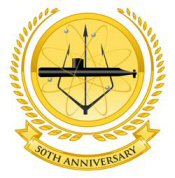
1960

|
USS SARGO (SSN 583)
1960 |

Click on the pictures to enlarge!
| In an arctile appearing in the PATROL magazine a number of the crew were photographed prior to departing for the Arctic in January, 1960: |

1960 WINTER ARCTIC EXPLORATION
| VADM John Nicholson recounts his experiences during the 1960 Winter Arctic Exploration cruise: |
| "Nautilus' course into the polar regions had been through the Bering and Chukchi Seas -- the shallow route into the deep North Canadian Basin, some 75 degrees north latitude. But even in the summer her way was blocked repeatedly by deep ice ridges extending as much as 80 feet down from the surface. Time after time she had been forced to backtrack and try new routes before she got through. And once, the boat (which measured 50 feet from keel to top of sail) passed under an 80-foot deep ridge in 142 feet of water, leaving only six feet clearance above and below! Because Nautilus's sonar couldn't detect deep ice ridges until they were virtually overhead, Commander Anderson had broken off the mission., Nautilus returned to Pearl Harbor, was refitted with the proper equipment and eventually made a successful transit to the Pole. |
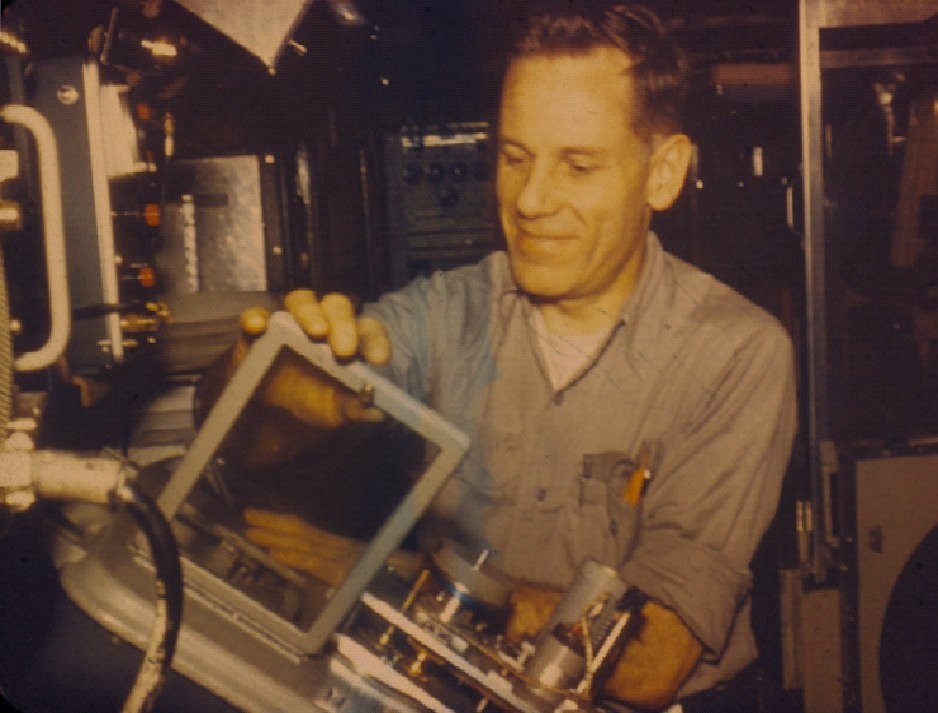 Courtesy John Nicholson
Courtesy John Nicholson
|
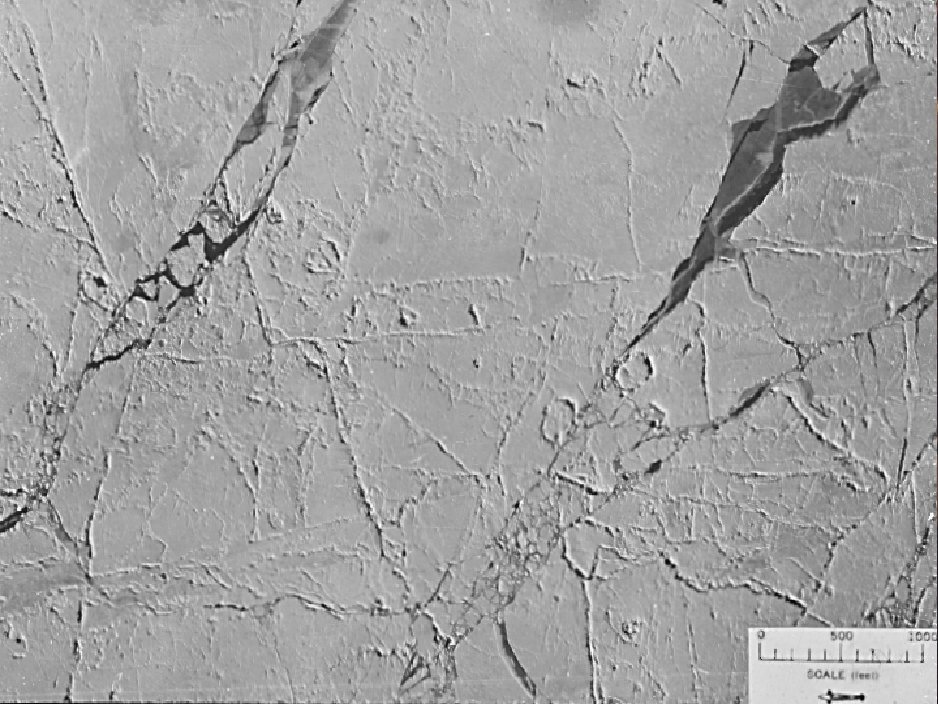 Courtesy John Nicholson
Courtesy John Nicholson
|
|
| Dr. Waldo K. Lyon | Aerial Photo of the Ice Pack |
|
"Getting Sargo ready made for the most hectic four months imaginable. Yard workers labored frantically, even
on Christmas and New Year's Day, to finish the job on time. Then immediately after installation was completed,
Sargo was off for sea trials. The inertial navigation system was tested, vertical ascents and descents were
practiced, and the new iceberg detector was tried out. This was tested using another submarine in place of the
ice ridges the Sargo would face. From these exercises we were able to check out the equipment, learn its range
capability, estimate depths of "ice ridges", and familiarize ourselves with appearances of various objects on
the scope of the overhead sonar.
"We were ready to leave for the north when I got a pessimistic letter from an old friend from my days aboard Skate, Walt Witmann, the Navy's senior ice forecaster. He predicted, after reconnoitering the northlands, that the winter would be a particularly tough one. Bering Strait, the gateway to the Arctic from the Pacific side, might have such deep ice ridges it could be closed to submarine traffic. With that letter in my pocket I slept uneasily the last few nights before we cast off for the north. But I kept the bad news to myself. One week out of Pearl, Sargo surfaced. We had made good time underwater past the Aleutian and Pribilof Islands, and was nearing Saint Matthew Island in the Bering Sea, still some 1,800 miles from the North Pole. A navigational fix was needed before going under the edge of the ice pack, which was only a few miles north. In fact I was much aware of ice as Sargo was cautiously surfaced with periscope and antennae retracted into the sail. Such caution moreover paid off. As Sargo broke the surface, chunks of ice bounced off her, making sharp rapping sounds on the hull. Seals cavorted about, and dead ahead was the solid edge of the ice pack. We were at the starting line and now our work had begun. "We then contacted the Staten Island, one of the five U.S. icebreakers. She was thirty-one miles to the north. Our orders were to rendezvous with her before we began the long and difficult Arctic exploration. |
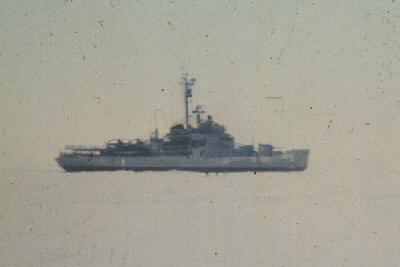 Courtesy Robert Connelly
Courtesy Robert Connelly
|
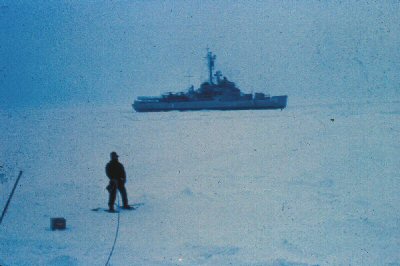 Courtesy Robert Connelly
Courtesy Robert Connelly
|
|
| Photo of the STATEN ISLAND (AGB 5). | Photo of the STATEN ISLAND (AGB 5). |
| "We closed with Staten Island after a vertical dive out of the drift ice around us, and tested our iceberg detector and overhead sonar as we went. Close by the icebreaker, we established underwater telephone contact with her, then surfaced nearby. Commodore Robertson, the Royal Canadian Navy's top Arctic expert, and Staten Island's skipper, Comdr. Larson, came aboard for a one-day, under-ice demonstration on Sargo. Later, during the night as we cruised close to the Staten Island, the ice thickened directly overhead. Eager to transfer the two officers back to the icebreaker so Sargo could resume her transit through Bering Strait, I found that getting her back up through the heavy polar winter ice cap was no simple problem. |
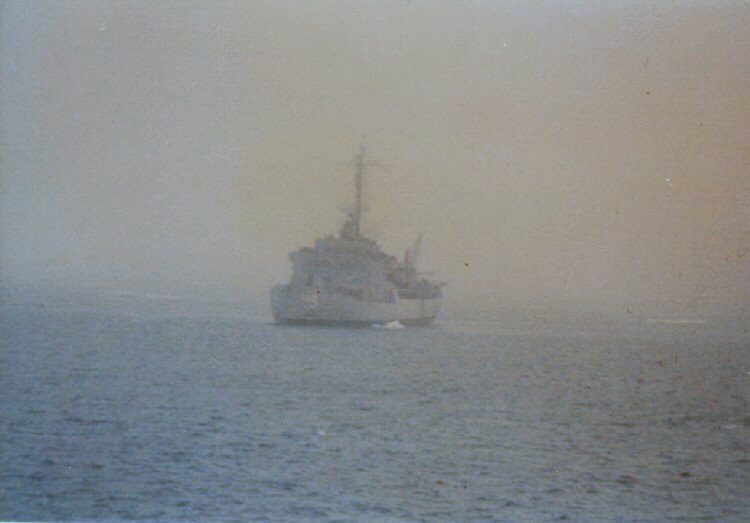 Courtesy James Smallwood
Courtesy James Smallwood
|
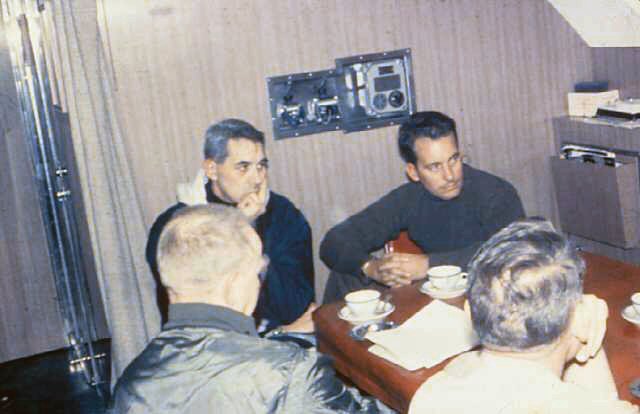 Courtesy John Nicholson
Courtesy John Nicholson
|
|
| Photo of the STATEN ISLAND (AGB 5). | A meeting in the Wardroom with Commodore Robertson. |
|
"We searched for a frozen polynya or lake with our upward beamed echo sounder. When one was found we performed
a Williamson Turn to go back down our track and find the polynya. We maneuvered to place Sargo in the middle
of the polynya and then began a vertical ascent with pumping and flooding of ballast to control her upward rate.
(if the overhead ice was hit too hard, serious damage to the sail with its periscopes, masts, antennae, and other
indispensable equipment might occur. If Sargo didn't hit hard enough, she wouldn't break through.)
"Sargo bumped the underside of the ice. Nothing happened. She hadn't broken through. The sonar showed one of the 25-foot deep ridges of ice was closing in on Sargo rapidly. Quickly negative tank was flooded and Sargo dropped to a keel depth of 120 feet. "We soon located another polynya, positioned Sargo and again tanks were blown cautiously until with an echoing bump Sargo rammed sail-first though the overhead ice. Then there was nothing. Sargo was hung up. I ordered Lt. Fred Stelter, our diving officer, to blow the ballast tanks. Almost immediately, with grinding and crunching sounds all around her, Sargo broke the rest of the way through the ice and into the air near the patiently waiting Staten Island. "I raised the periscope and saw the icebreaker 300 yards on Sargo's starboard beam. The only other thing I could see was solid ice all around. Opening the upper hatch, I went to the bridge and all but stumbled over the cockpit full of ice, the thickest any submarine had ever penetrated. On the after deck was an enormous block of ice five feet thick and measuring 15 by 20 feet - a 13-ton ice cube. |
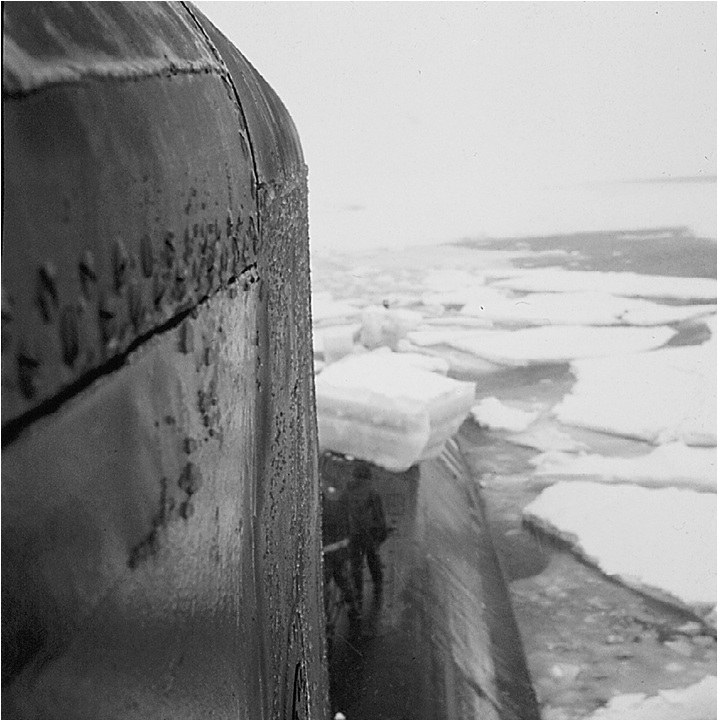 Courtesy John Nicholson
Courtesy John Nicholson
|
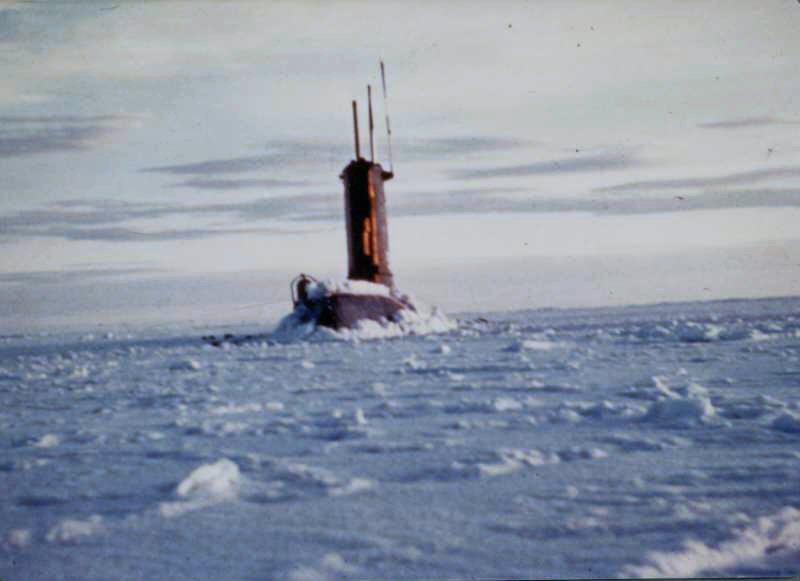 Courtesy Bill Hyde
Courtesy Bill Hyde
|
|
| Surfaced in the Bering Sea | Surfaced in the Bering Sea |
|
"After letting the Commodore and the Commander walk over to the Staten Island, we flooded tanks, dropped vertically
toward the bottom, and steered northward. At dawn the next day, Sargo cracked through the ice forty-one miles off
Saint Lawrence Island for a final navigational fix before running submerged through the shallow Bering Strait. The
day was bright and so clear that the hills of Saint Lawrence Island could be seen. One long last look at the world
above the surface was taken. We were not to see the sun again for twelve days after Sargo dropped out of this frozen
polynya and headed into the Arctic night.
"Slowly, Sargo cruised northward toward Bering Strait, keeping a keel depth of 100 feet. But the sea grew shallower and shallower as Sargo approached the fifty-mile strait that separates the U.S. from the U.S.S.R. By midnight she had crossed the 25-fathom curve and soundings shoaled rapidly up to 126 feet. Sargo was passing under 20-foot ice ridges and avoiding the deeper ones, thanks to the effectiveness of the iceberg detecting sonar. Adding to the problems was the scarcity of sounding in this area. As Sargo cautiously cruised along with barely more than 25 feet above and below her, it was a matter of groping our way along to find a way through. "Then the overhead sonar failed. This left us totally blind to what might be above Sargo. The ocean depth was a scarce 126 feet, leaving little leeway, so I gave the order to reverse course. With infinite care, our planesmen and helmsman brought Sargo about while maintaining a precise zero bubble. The slightest tilt could have resulted in her propellers grinding into the ocean bottom leaving her seriously disabled under the pack ice. (Sargo was backtracked for two miles before finder her way around the danger spot). "All this time the sonarmen worked feverishly to restore the all important over head "eyes," and they were up to the job. With repairs completed, Sargo moved on, threading her way at very slow speed among the treacherous icy ridges above, as if penetrating a minefield. For the next thirteen hours Sargo twisted and turned tortuously in an ordeal of ice. As the ridges got deeper, Sargo passed under some ridges as much as 52 feet deep and avoided many deeper ones. At the end of that thirteen-hour trek Sargo was nearing the Bering Strait. I decided to surface - if we could find a spot in this shallow sea. "The depth was 170 feet. I began maneuvering Sargo for a position to make a vertical ascent through a flat spot in the overhead ice. As we moved, we suddenly began losing depth control and started sinking rapidly toward the bottom. Quickly, I ordered the main ballast tanks blown to check Sargo's descent. Then I ordered the vents opened so Sargo wouldn't rise rapidly and hit the thick ice overhead. But the huge air bubbles which escaped so distorted the pictures of the overhead ice on the sonar that I ordered the boat down again to seek another skylight to burst through. It was two hours before one was found - in a shallow 170 feet. This time Sargo made the vertical ascent smoothly. Up she went and her sail hit the ice. Just as before, she stuck. Fred Stelter ordered the ballast tanks blown - but gently. Sargo's sail then broke through three feet of ice. A new record. The hull took an up angle, then a down angle, then an up angle again and the bow crunched through solid ice. Sargo's stern, however, remained below and she came to rest with a 4 degree up angle. "On the bridge I found the ice scattered about in huge chunks. Aft, the ice was even thicker, and it was this heavier ice that prevented Sargo's stern from coming up. But it was a great relief for us all to be above the ice again, even if briefly. We were only halfway through our shallow transit and the pressure on the entire crew was great. We got a radar fix on Cape Prince of Wales, the westernmost point on mainland Alaska and the next morning Sargo made a vertical dive out of the ice. Fred Stelter expertly dropped her down and leveled her off at 120 feet - but the many hours in the ice had frozen the bow plane controls so they couldn't be used for the intricate depth control and trimming needed. Even using the bow planes, it was difficult enough to maneuver and maintain depth control. Without them it was almost impossible at slow speeds. "A new technique was developed very quickly. Sargo was cruised at higher speeds than heretofore and a maximum rudder angle of only 3 degrees was used. If a faster turn was required to dodge the rock-hard ice ridges overhead we used 5 or even 10 degree rudder but then needed to blow ballast tanks to keep off of the bottom and counter flood the negative tank to keep from smashing into the ice above. It was nerve wracking. "Once Stelter had Sargo down, she was jockeyed about warily for half an hour before a clear corridor could be found which headed in the general direction desired. Then for the next three hours, the depth continued at around 140 feet. We maintained 20 feet of water between Sargo's keel and the bottom until suddenly the soundings decreased to 10 feet below her keel. Then, just as suddenly they sloped sharply off to 55 feet before shoaling up quickly again to 40, 30, 20, 10 feet. The bottom was still rising when the diving officer on watch, Lt. Dave Phoenix, ordered the boat up 10 feet, just in time. As he blew the main ballast tanks with the vents open, the boat surged up 10 feet. At the same time the fathometer registered only five feet below Sargo's keel. We braced ourselves to bounce off the bottom but the soundings went deeper again before Sargo could hit bottom. Many sighs of relief were breathed. The planesmen named the sea mount we had just crossed, "Tall Gonzales". "Immediately after the climb over Tall Gonzales, word got to the crew quickly of our narrow escape. After that, virtually everyone huddled around the iceberg detector to watch Sargo being conned around the overhead ice ridges. Alternating at the conn with me were my executive officer, Lt. Comdr. Bill Yates, and my engineering officer, Lt. Comdr. Ned Dietrich. Watching the iceberg detector reassured all hands as they saw how ice ridges were spotted and a course was plotted around each one. "With the tight squeeze behind, Sargo transited Bering Strait late in the afternoon and by early evening had crossed the Arctic Circle without ceremony. Our objective, the North Pole, was still 1,400 miles off. Sargo ran north all that night, and on the thirteenth day out of Pearl Harbor things went routinely for the first time in a week. As Sargo continued north the water got deeper - 180 feet. Seldom had 30 fathoms looked so invitingly deep to a submariner. With the deeper water and the simple transit, the bow planes were worked, trying to free them from their icy bonds. Frequent manipulation was used to loosen the frost-bound controls. But it wasn't until later that the bow planes were finally freed. "The next day was the fourteenth out of Pearl and a navigational fix was needed. But at this point, the bow planes still weren't freed. Without that gear we had to resort to frequent blowing of ballast to make a vertical ascent. The air bubbles unfortunately threw off the sonar so that when Sargo tried to surface through what appeared to be thin ice, she couldn't poke through. The ice was thicker than the instruments indicated. Sargo was dropped out of that spot, and some hours later, after the bow planes finally were working properly, and after one more unsuccessful attempt to crack through the ice, she surfaced through a skylight only 13 inches thick. "The brief time on the surface allowed a navigational fix and radio reports. Also two of our divers plunged into the 29 degree water for 22 minutes. It was their first cold water dive. While in the water, they checked the malfunctioning garbage ejector and removed a flattened can that had jammed it closed. Later they made other repairs. "We decided to send Valentines Day poems to our boss to send to our wives and held a contest for the best poems. Two of the submittals were:
Violets are blue The nudes on the bulkhead Remind me of you. And
Roses are red
|
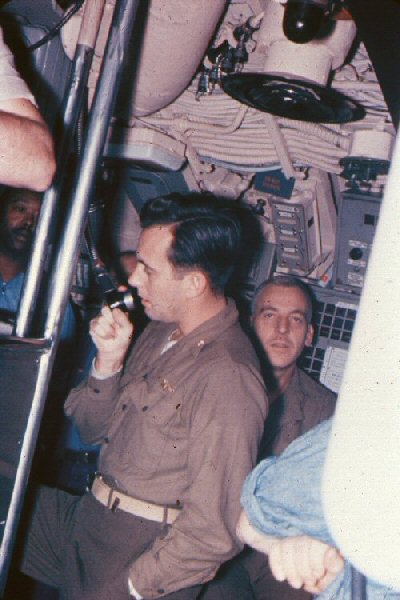 Courtesy Robert Connelly
Courtesy Robert Connelly
|
| LCDR Nicholson addressing the crew as the USS SARGO passed beneath the North Pole. |
|
"Next day, Sargo resumed her northward course. The bow planes were again frozen but this was of little worry
as the 50-fathom curve and then the 100-fathom curve were passed. Speed was increased to 16 knots as Sargo
zigzagged her way toward the top of the world. Our momentary relief at being in deep water was short-lived
as the iceberg detector failed. We had to fix it or replace it if we were to be able to return via the Bering
Strait rather than the Panama Canal. So on the following day Sargo was surfaced through 7 inches of ice in a
600 by 2,000 yard frozen polynya. Repair of the iceberg detector was then begun. Working in twenty below zero
weather, two men at a time worked in half-hour shifts to dismantle the train mechanism and get it below for
repairs. The heavy support beam under the detector had to be cut before it could be lowered to the deck below.
During this, there was a screeching and groaning of ice as it was being forced up and over the Sargo's main
deck. After 40 hours, with the training mechanism finally gotten below, Sargo dove and continued zig zagging
our way towards the Pole. We discovered a lot of previously unexplored territory including a ridge subsequently
named Sargo Ridge.
"At 0934 on February 9, Sargo passed 350 feet under the North Pole, and after announcing our arrival at the Pole, Sargo began searching for an opening. A small one was discovered and Sargo smashed through 3 feet of ice and surfaced just 25 yards from the Pole. It was 33 degrees below zero as we raised the Hawaiian State Flag alongside the Sargo. |
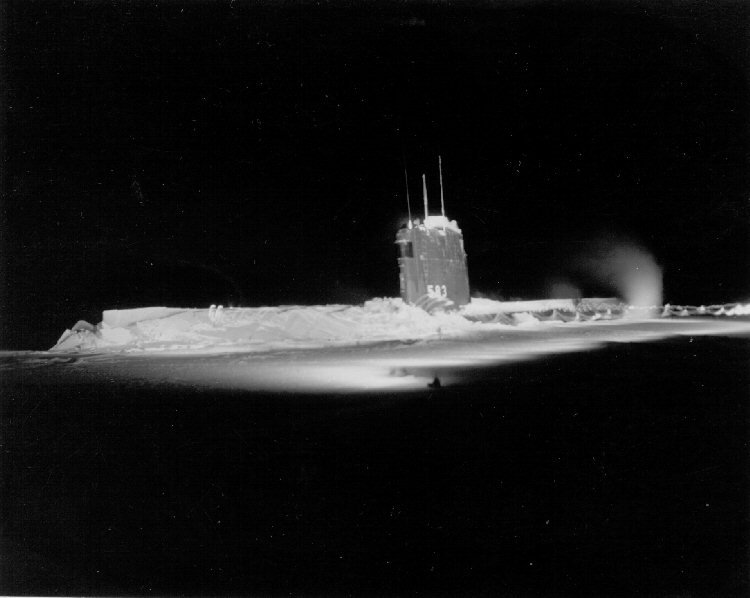 |
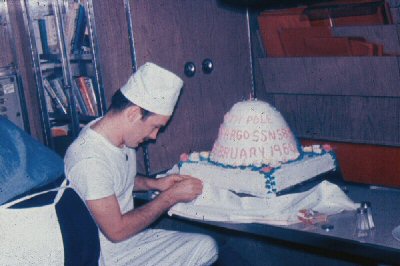 Courtesy Robert Connelly
Courtesy Robert Connelly
|
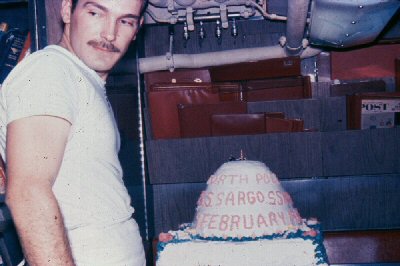 Courtesy Robert Connelly
Courtesy Robert Connelly
|
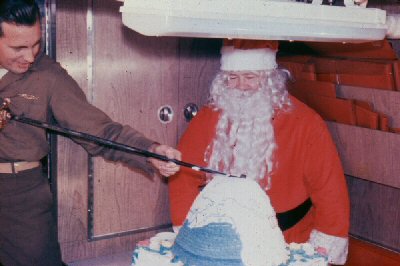 Courtesy Robert Connelly
Courtesy Robert Connelly
|
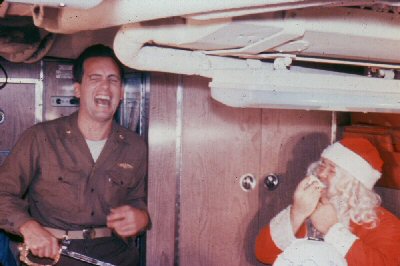 Courtesy Robert Connelly
Courtesy Robert Connelly
|
|
| Cutting the "North Pole" cake in the Wardroom. | ||
| "When Sargo attempted to dive that night she was frozen in solidly. It took 30,000 pounds of extra ballast to tear her loose and start her plummeting down. We got a trim in time and then circled the earth in seven minutes. (That's real easy when so close to the Pole). Then Sargo headed South, the only possible direction to go from 90 degrees North." |

| One of the problems with operating a submarine under the ice canopy of the Arctic Ocean is the concern for being able to surface the submarine in a timely manner should there be an emergency onboard (fire, flooding, etc.) and the submarine find itself in need of being "on the top." To answer this concern the use of an explosive device to punch a hole in the ice canopy was considered. The explosive device that was settled upon was the MK-19 submarine launched mine. |
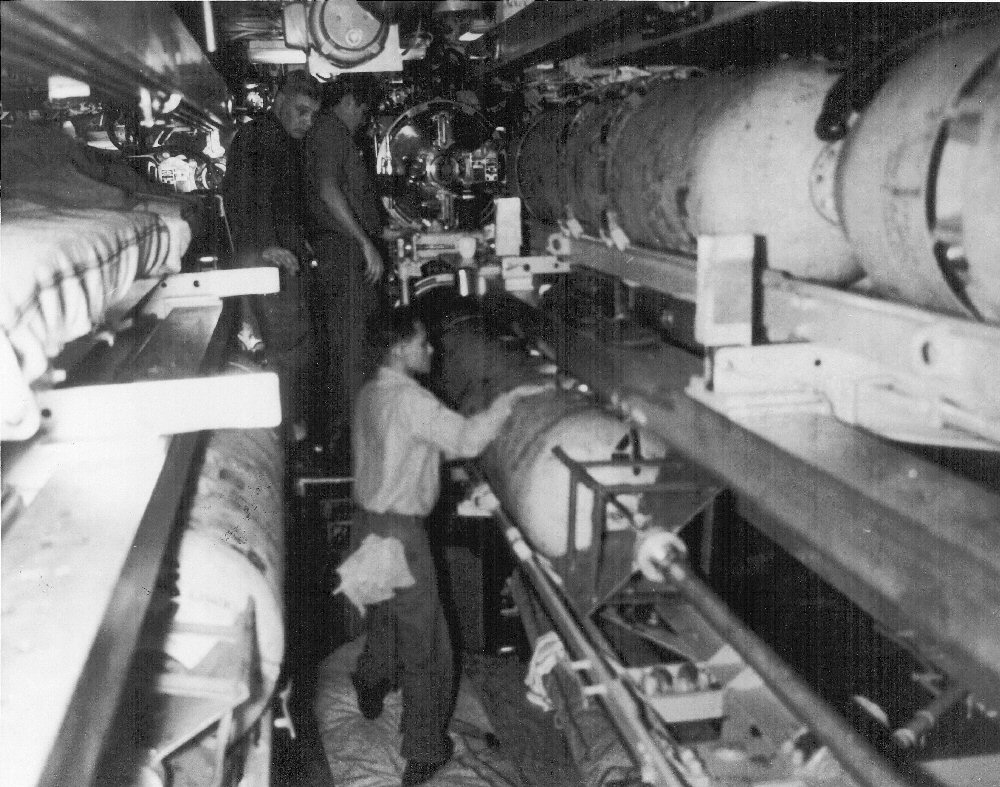 Courtesy Mike Hacking
Courtesy Mike Hacking
|
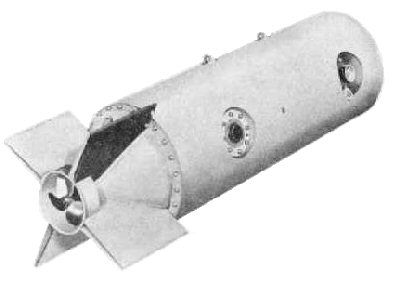
|
|
The MK-13 mine was designed by the USN, as a moored magnetic-influence mine, had an aluminum casing, and weighed
1118 lbs. The warhead was 710 lbs of TorpEx. A sister project by the U.S. Army Air Corps was the MK-19, this used
a better type of magnetic-influence fuse and was armed via a revolution-counting impeller. The USN evaluated the
MK-19 and ordered them as the MK-19 Mod 2.
One of SARGO's mission assignments was the test of modified MK-19 mines for use as an emergency method of surfacing through the ice canopy. VADM John Nicholson shared the following excerpts [with notes of clarification] from the journal he kept for the 1960 Winter Arctic Exploration cruise: |
|
"0205 - c/c to 132 to head into McClure Strait. "Started coming up at 0743. NK and BQN [Topsounder Recorder] estimated less than 1 foot, looked thru scope. Very good visibility. Ice looked free of ridges but looked solid - I estimated 1-foot or more. "Hit somewhat slower than usual at 49-1/2 feet (indicating 6-inches). A slight blow forward and aft and she broke through with a jolt - even the deck hit fairly hard.
|
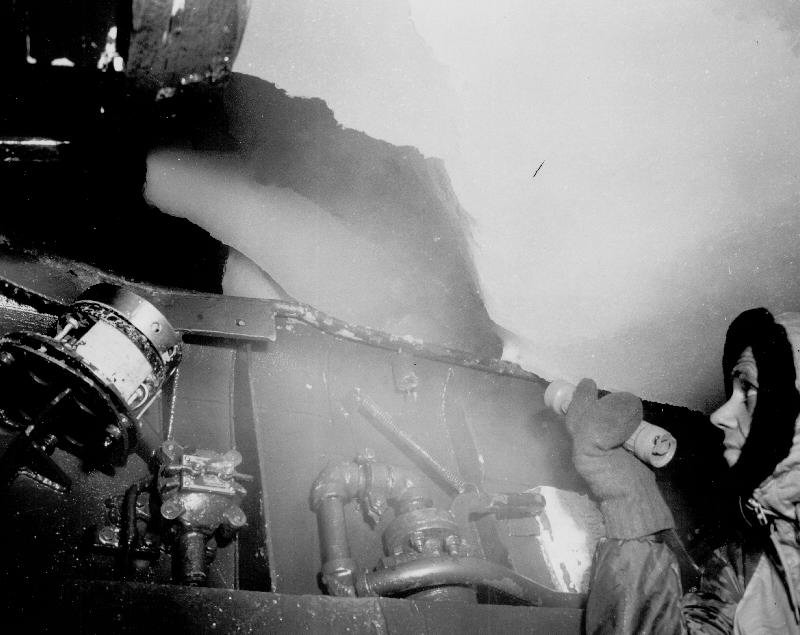 Courtesy John Nicholson
Courtesy John Nicholson
|
| The Cockpit full of Ice. |
|
"The cockpit was covered as usual - 20-inches of ice. Decks remained under but Sail Door was free (6-inches of water
on deck) so used it for access.
"Extremely long, flat polynya with a pressure ridge 200-300 yards ahead (had been seen on 1BD and VQS). Primarily wanted a fix here. "Took bars off radar but could not pick up land. Replaced magnetron but still no luck. "Sun came up (but not much). Very cold (-25 with a wind) which made picture taking uncomfortable. However it was so good to have some sunlight even though meager that lots of us snapped away. Not spectacular but good. "Decided this would be a good spot to fire our ice destructors [MK-19 mines]. This big stretch of 20-inch ice would give us a good base of operations to fire the destructors in various thickness of ice. "Dropped out of our hole at 1210 and got ready to fire destructor. Fired at 1241 about 100 yards from our hole and opened out to 2000 yards after dropping down to 200-feet. Could not see mine go out through scope but visibility was not very good. It was clear of the tube. Mine will not go off below 89-feet so stayed at 200-feet in case it was attached to us. Unit was supposed to go off at 15 minutes but though we waited 21 minutes did not hear a thing (1600 yards away at 15 minutes, 1000 yards at 21 minutes). "It was not now feasible to fire other mines in this area since we had to wait 90 minutes below 89 + 49 - feet to ensure unit was disabled. Decided to continue on our track and try again in 90 minutes. Very disappointing. These destructors are supposed to be our ace in the hole in case we have a casualty. Will try 2 or 3 more to make sure it was not an isolated failure. "At 1420 fired another destructor at some thin ice - used pin in new location as suggested by NOL. Again a dud. Saw this one leave tube and shoot to the surface. Very good visibility. "At 1455 fired one more and again a dud. Decided to test soluble washer - it's the only reason we can think of why they're not going off. Also saw this one go to the surface." |
| [While the Sargo's tests of the MK-19 mines was disappointing, subsequent testing determined that while explosions did break up the ice canopy the broken ice rapidly refilled the hole created, thus making it unrecognizable and therefore of no utility.] |
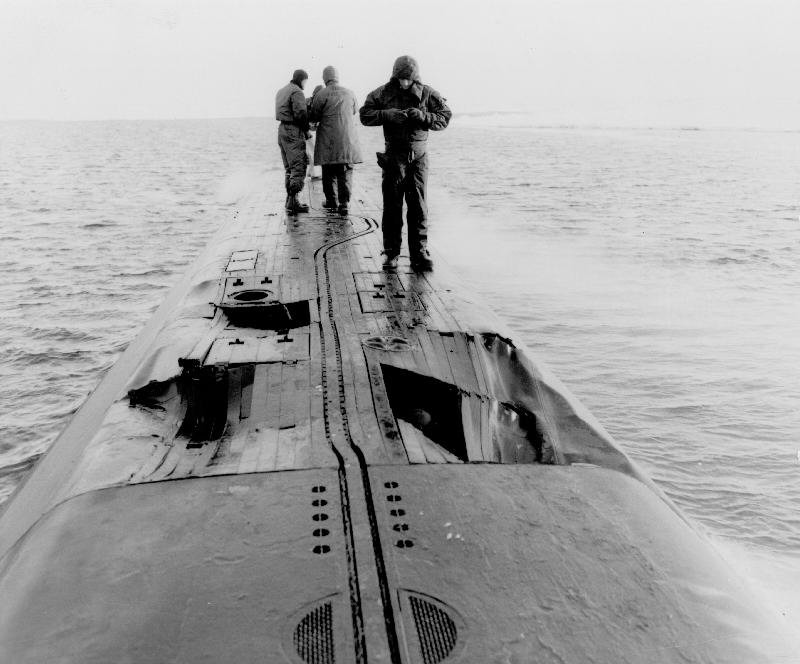 Courtesy John Nicholson
Courtesy John Nicholson
|
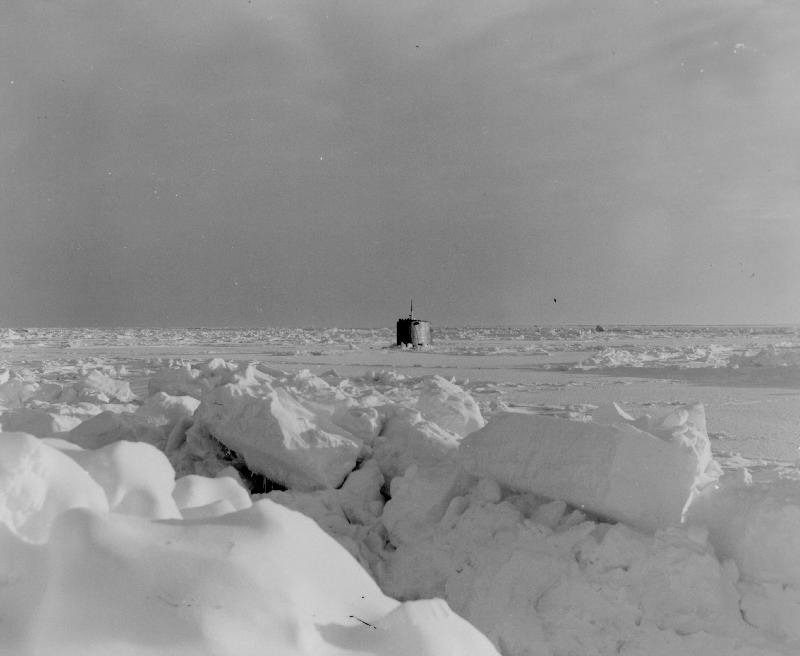 Courtesy John Nicholson
Courtesy John Nicholson
|
|
| Damage to the AFT Deck. | The SARGO surfaced in McClure Strait. |
|
"1538 surfaced about 1000 yards from two destructors through only about 1-inch of ice. Temp only -25 but bitter cold
due to 20 knot winds. Water surface very interesting with all this new ice. Wittman says the wind has shifted and this
will change conditions in the strait. Inspected topside - found a large hole in the deck just aft of EHX [Emergency
Heat Exchanger]. Nothing serious but apparently it occurred on this morning's surfacing. Also the UQS guard is down
against the UQS dome. Decided to hold number of surfacings to a minimum for the remainder of the cruise.
"1654 dove. Hope to surface and get ST fix to make soundings we're getting more valuable. "No opening - will continue on track to link last known soundings but will have to take conservative track. Iceberg detector + SQS-4 furnishing protection as well as UQN. "1900 - We're planning to surface as soon as possible to send sitrep + repair main circ pump. "At midnight decided to take off execute [order] until dawn. Have penetrated McClure Strait to a point which joined up previous soundings. Bottom very flat + over 200 fathoms. Ideal submarine passage.
"Still in mouth of McClure Strait enroute to Ice Station Bravo looking for a hole. "Executed on a large flat section estimated about 3-feet thick. 3-feet doesn't bother us at all anymore. Broke through at 0901 after hitting at 50-feet [ascent rate of 50 feet per minute]. A look through the scope on the way up indicated very flat absolutely no nearby ridges - I estimated thickness at 2-3-feet. "The thickness of the ice on the bridge was 22-inches this time and we were in a beautiful frozen polynya about 700 by 1500 yards surrounded by ridges 12-feet to 24-feet high. Sun was up about 1-degree. Beautiful day for pictures. Sail only came through. Ice over forward deck was all broken up. Could have broken on up but we preferred to leave deck under. "Commenced replacing the seal on STBD main circ pump at 0915. Boys are determined to beat SKATE's time of 7-hours during their winter cruise. "During Walt's [Walt Whitmann] trek to the pressure ridges he and the rifleman discovered fresh polar bear tracks. There was great excitement when the news got back. A big game hunting party was quickly formed and after arranging for proper safety signals ... off they went. They did find numerous tracks and a cave in the ice where there had been recent bears but no luck. They returned undaunted and even more eager to get one next time. "Was amazed when the Engineer came up at 1330 and said the pump was repaired and had been tested - only 4 hours + 15 minutes. Engineer also claimed they'd done it with one hand tied behind their backs. RM claimed they gotten msg out with both hands tied behind their backs. "Dropped out of this delightful spot and headed for Bravo. We really feel like we're heading home. Making a dog leg to get better bathymetry and give USNUSL a better test. "Spent some time at 130-feet testing 1BD. We really feel its working well and will not require repair. What a relief. Roshon, Page, and Walker have really come through. Will pick up spare motor + projector if it is handy. "Several large polynyas up to 5 miles long and 1-foot thick - big improvement over Canadian Archipelago."
|

| VADM John Nicholson continues to recount his experiences during the 1960 Winter Arctic Exploration cruise: |
|
"Enroute South, the iceberg detector was jury rigged with another sonar by an ingenious system of synchros, gears and
linkages devised by our crew and two designers of the iceberg detector. Tests with the modified ice detector proved
satisfactory. Later Sargo rendezvoused with Ice Island T-3, drifting in the Beaufort Sea and manned by a crew of
scientists. After passing under the ice island and determining it to be 4 miles by 10 miles in size and 160 feet deep,
we conducted sonar tests with them and then headed back toward Bering Strait.
"Just before entering the Strait, Sargo was surfaced through thick ice and a navigational fix taken. Then Sargo dropped out of the ice into 155 feet of water and cruised at 7 knots into Bering Strait -- 24 feet off the bottom. The deep ice ridges began to appear, but evading them was tougher because of the shortened and distorted ranges provided by the jury-rigged detector. Later, when a pair of deep ridges were spotted 500 yards ahead, I ordered a course to take Sargo between them. At 125 yards, the ridge off the port bow looked very deep while the one on the starboard side had disappeared. I altered Sargo's course 15 degrees to starboard and WHAM! The boat heeled to port as it was shoved down 25 feet, with a 6 degree down bubble. The conning officer sounded the collision alarm and rang up "all stop". With the depth gage reading 148 feet, almost on the bottom. I took the conn, ordered "back two thirds" then ordered ballast tanks blown while leaving the vents open. As Sargo came up, I ordered "ahead two thirds" on one shaft and we regained depth control. Sargo was clear of the ridge and all compartments reported "no damage". It was a close call." |
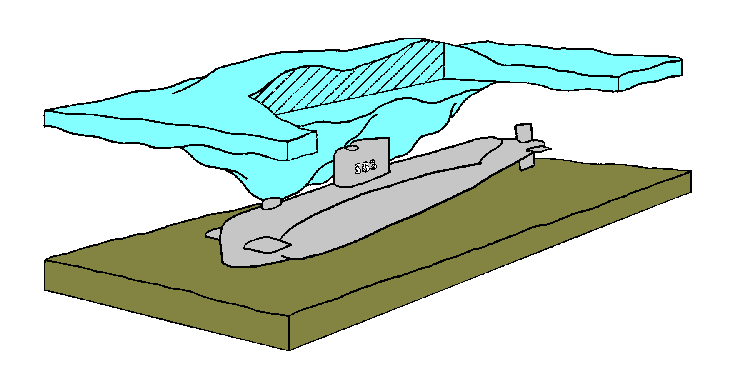 Courtesy John Nicholson
Courtesy John Nicholson
|
| Artist's conception of the Ice Keel. |
 Courtesy Earl Gale
Courtesy Earl Gale
|
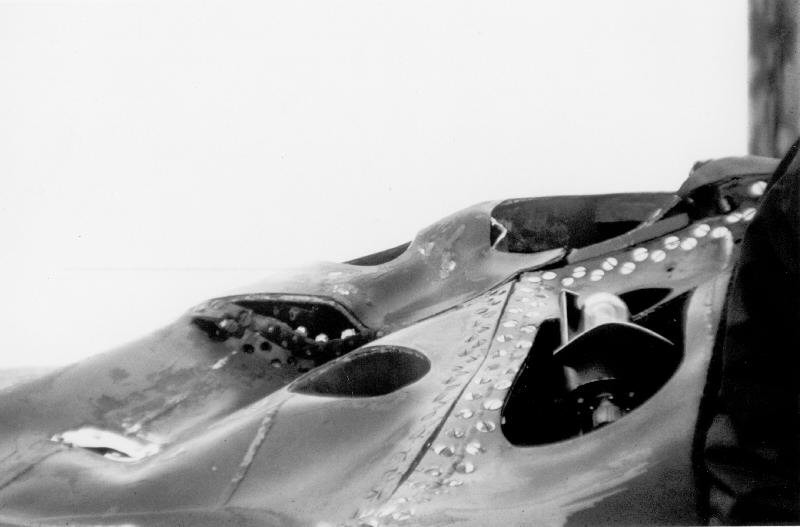 Courtesy John Nicholson
Courtesy John Nicholson
|
|
| Damage to the Sail | Damage to the Sail |
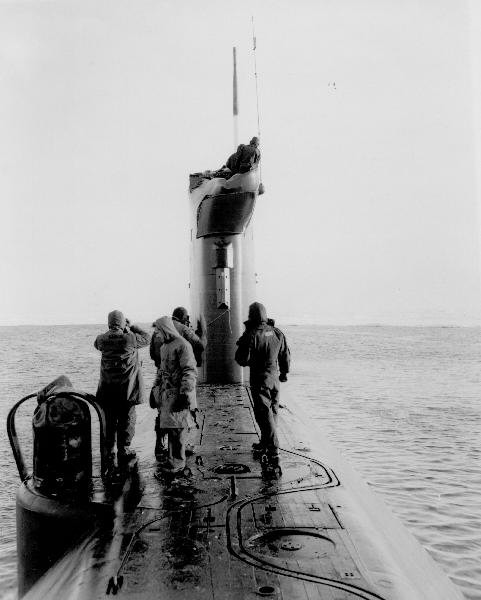 Courtesy John Nicholson
Courtesy John Nicholson
|
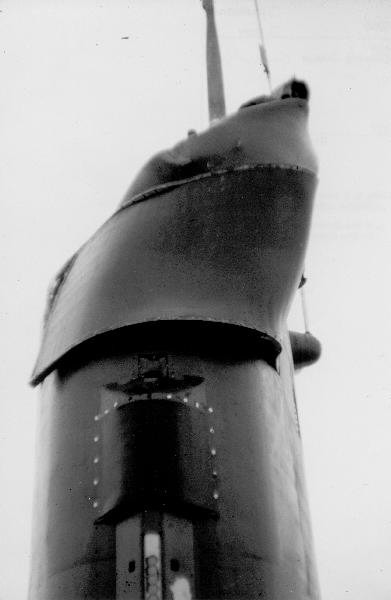 Courtesy John Nicholson
Courtesy John Nicholson
|
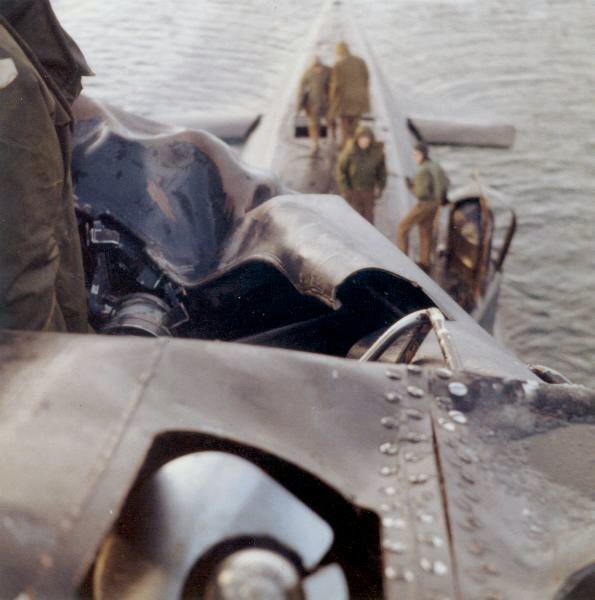 Courtesy John Nicholson
Courtesy John Nicholson
|
||
| Examining the damage. | Sail damage. | Sail damage. |
|
"We determined that our modification of the iceberg detector had resulted in unwanted side lobes on the short scales,
so we decided to leave the iceberg scope was left on the long scale, and maneuver around the ridges while still 600
yards away. Additionally, Sargo cruised 16 feet off the bottom to give more clearance from the ridges. But late on the
next day, a solid wall of ice was spotted 800 yards ahead. Scanning the huge ice ridge showed no openings, so Sargo was
steered parallel to the ice wall for a long period until she was able to skirt around its end and resume base course.
"As soon as possible we surfaced to inspect the damaged sail. It was quite a sight. The top of the sail was dished in so that one of the periscopes couldn't be raised, but the supporting members in the sail were sound. We had been very lucky. "There was just one trouble spot left "Tall Gonzales". I planned to avoid this pinnacle by 5 miles, but then the inertial navigational system chose to get out of line a bit. Despite my calculations for set and drift to compensate for the system errors, soundings showed the bottom shoaling up rapidly under Sargo and a deep ridge up ahead. I reversed course and headed for deeper water just as the boys put the inertial navigator back on the line. The corrected equipment showed we were five miles North of our estimated position, hard by Tall Gonzales. We dodged our way through another field of heavy ridges and finally reached better ice conditions. "Two days later, February 25, Sargo cleared the ice pack after traveling 6,003 miles and 31 days under the ice and successful accomplishment of a very risky operation. One crewmember summed up our thoughts, "The only ice I want to see for a long time is in a tall glass." |
| When she returned the ship had logged 11,136 miles, 6003 miles under the ice, and all but 300 miles submerged. The winter Arctic Ocean was a great unknown and SARGO collected extensive scientific data. Arriving at the North Pole, on 09 Feb 1960 she surfaced through 36 inches of ice, establishing the U.S. Navy's capability for year-round access to the Arctic Basin, from the Pacific Ocean. |
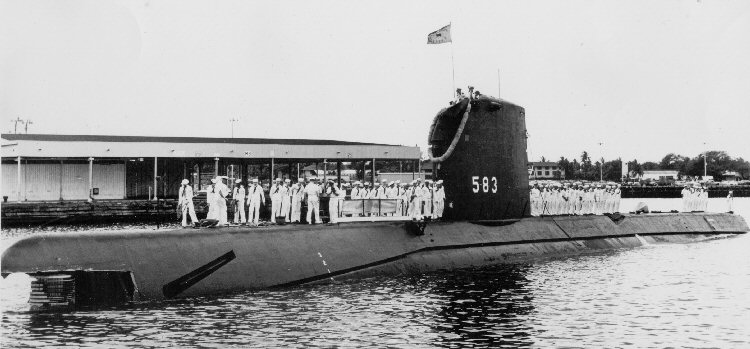 Courtesy Robert Fay
Courtesy Robert Fay
|
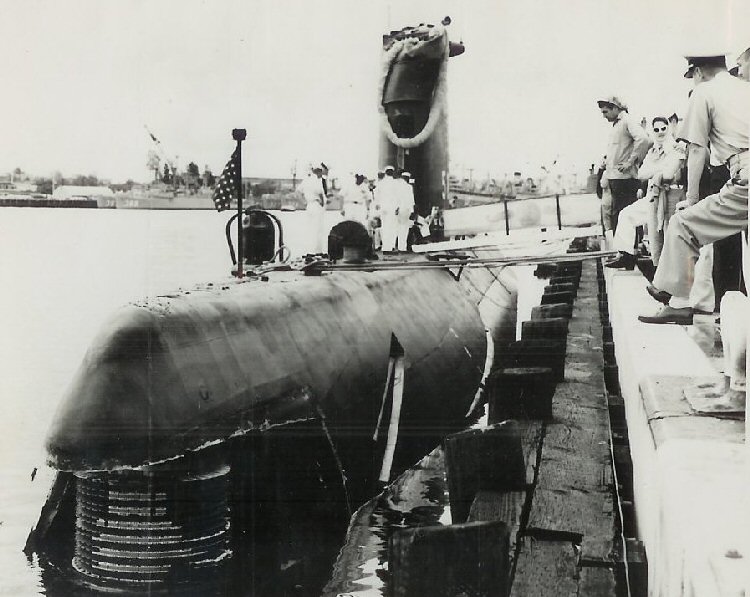 Courtesy Donald Taylor
Courtesy Donald Taylor
|
|
| Returning to port after a challenging deployment. | USS SARGO (SSN 583) returns to Pearl Harbor. |
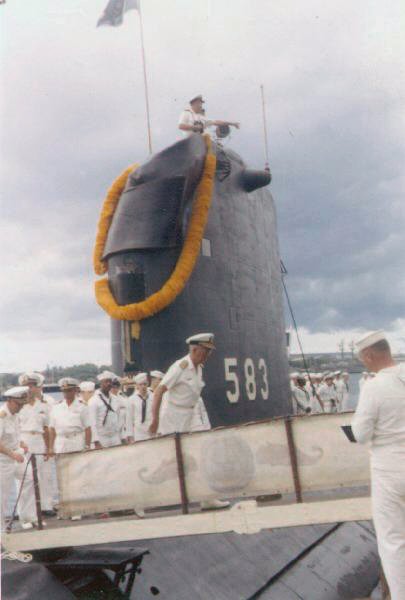 Courtesy John Nicholson
Courtesy John Nicholson
|
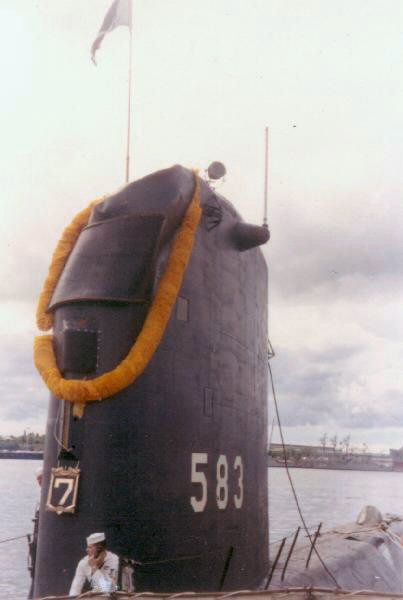 Courtesy John Nicholson
Courtesy John Nicholson
|
 Courtesy John Nicholson
Courtesy John Nicholson
|
||
| Liberty. | Liberty. | Nicholson greeted by wife Pat and daughter Laurie. |

| Don Taylor ET2(SS) (1960): |
| "On the return trip from the Arctic in 1960, a can of beer was spotted in the Lower Level Engine Room bilge. There was ice in the bilge which needless to say made it a cold beer. After two to three days of trying at various times to capture that beer, someone finally did. I never knew who got the beer or where it came from." |

| LT Thomas L. Walker (1957 to 1962): |
| "After the collision using the Sonar repair which replaced the Sail-mounted Transducer with the BQR hydrophone that was under the Bow for iceberg detection it was said 'Well that should have been expected, move your eyes from you head and put them in your knees and see if you don't bump your head once in a while!" |

| Bob Fay YN2(SS) (1959 to 1960): |
| "My biggest memory of SARGO was handling some 15-20 thousand letters that were sent to the ship before sailing for canceling with the time and date of the surfacing at the North Pole. I was the Yeoman at the time, and in fact, was designated by the U.S. Postal Service as a temporary Postmaster for the trip." |
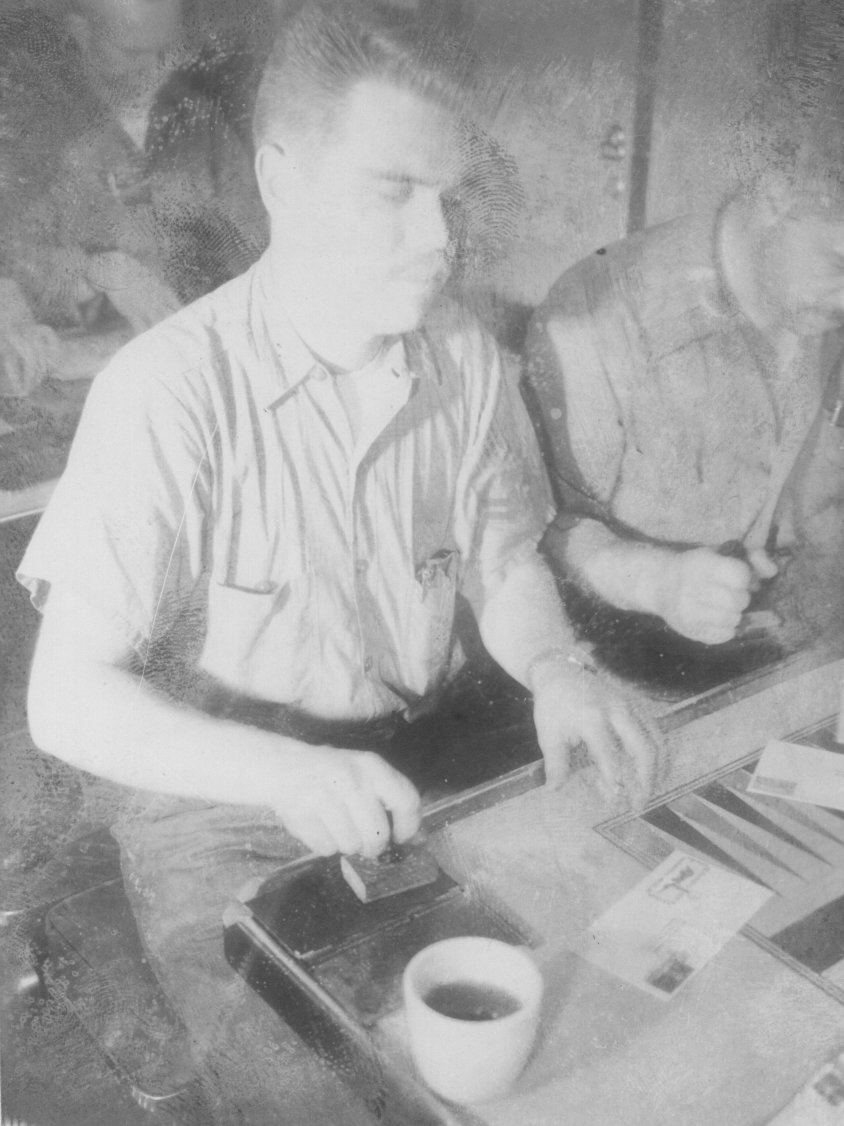 Courtesy Robert Fay
Courtesy Robert Fay
|
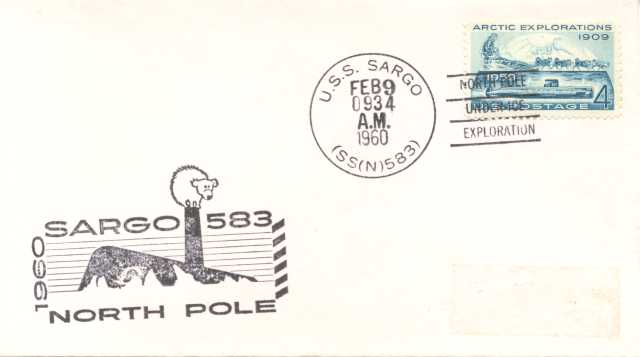 Courtesy Michael Hacking
Courtesy Michael Hacking
|
|
| Bob Fay cancelling cachets. | The Official Arctic Deployment Cachet. |

| Tom J. Hansen YN2(SS) (1959 to 1962): |
 Courtesy Tom Hansen
Courtesy Tom Hansen
|
 Courtesy Tom Hansen
Courtesy Tom Hansen
|
 Courtesy Tom Hansen
Courtesy Tom Hansen
|
||
| Tom Hansen in the Control Room. | Tom Hansen in the Control Room. | Tom Hansen in the Control Room. |
 Courtesy Tom Hansen
Courtesy Tom Hansen
|
 Courtesy Tom Hansen
Courtesy Tom Hansen
|
|
| Tom Hansen's Blue Nose Certificate. | Tom Hansen's Blue Nose Card. |
| The following photos are of the USS SARGO (SSN 583) returning to port at Pearl Harbor following the Arctic deployment: |

| James Smallwood Stevens, son of Alvan T. Stevens FTC(SS) (1959 to 1960) provided the photo below: |
| "Here's a photo of my Dad, Fire Control Technician Alvan T. Stevens (1927-1978) on the Sargo sometime in 1960, I'm guessing." |
 Courtesy James Stevens
Courtesy James Stevens
|

| Robert Stewart was a civilian onboard for the Arctic deployment responsible for the continued operation of the Autonetics N6A navigation system and shared the following: |
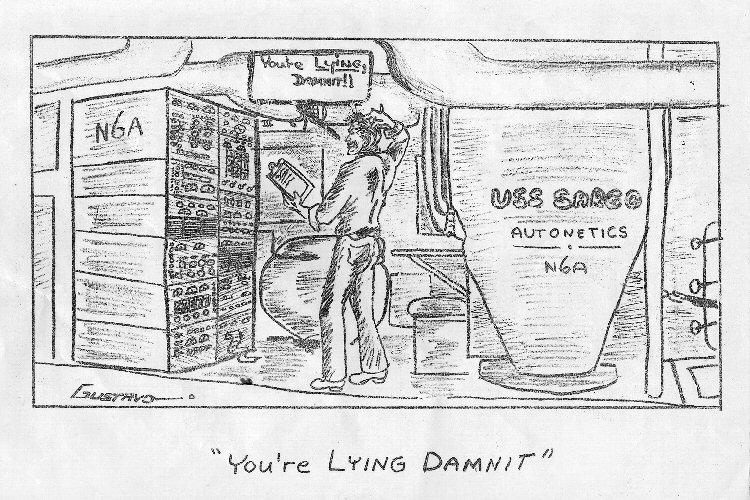 Courtesy Robert Stewart
Courtesy Robert Stewart
|
| A cartoon which appeared in the Sargo newsletter while underway. |
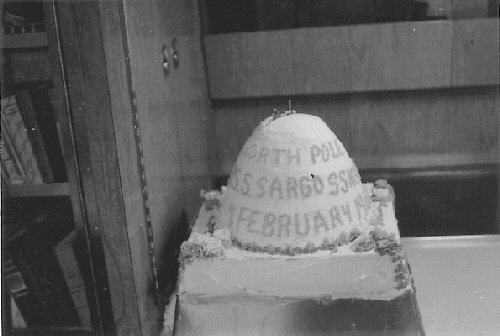 Courtesy Robert Stewart
Courtesy Robert Stewart
|
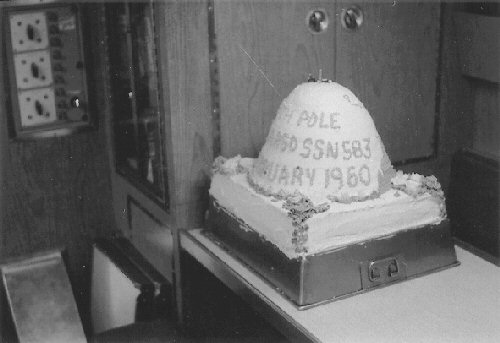 Courtesy Robert Stewart
Courtesy Robert Stewart
|
|
| A cake baked to commemorate the Sargo surfacing at the North Pole. | A cake baked to commemorate the Sargo surfacing at the North Pole. |
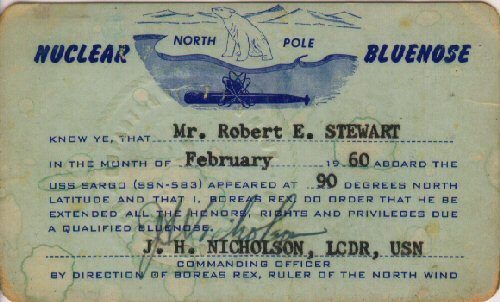 Courtesy Robert Stewart
Courtesy Robert Stewart
|
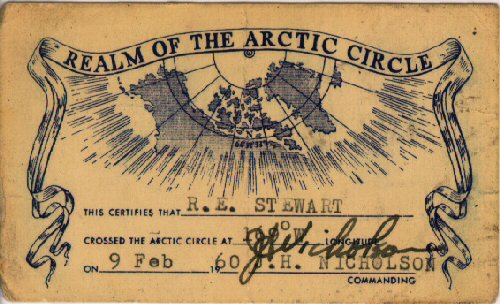 Courtesy Robert Stewart
Courtesy Robert Stewart
|
|
| Bob Stewart's Blue Nose Card. | Bob Stewart's card certifying his crossing of the Arctic Circle. |
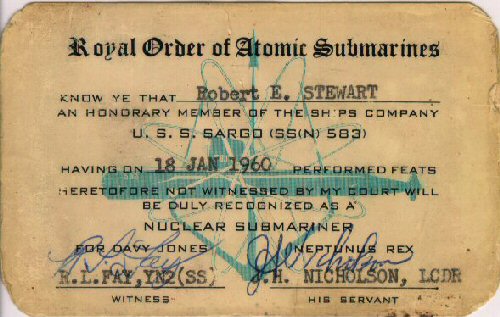 Courtesy Robert Stewart
Courtesy Robert Stewart
|
| Bob Stewart's "membership" card as an honorary member of the ship's company. |
| Following the deployment to the Arctic Robert Stewart published a report on the performance of the Autonetics N6A navigation system. The following link is to that report: |

ADDITIONAL LINKS AND INFORMATION FOR THE
1960 WINTER ARCTIC EXPLORATION
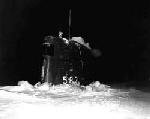
|
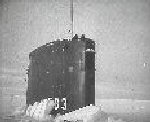
|
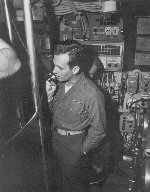
|
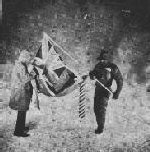
|
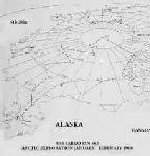
|

|

|

|

|

|

| Official Navy Photos provided to AP and UPI are shown below: |

| Following the ship's completion of the Arctic cruise the USS SARGO (SSN 583) received the following message traffic: |
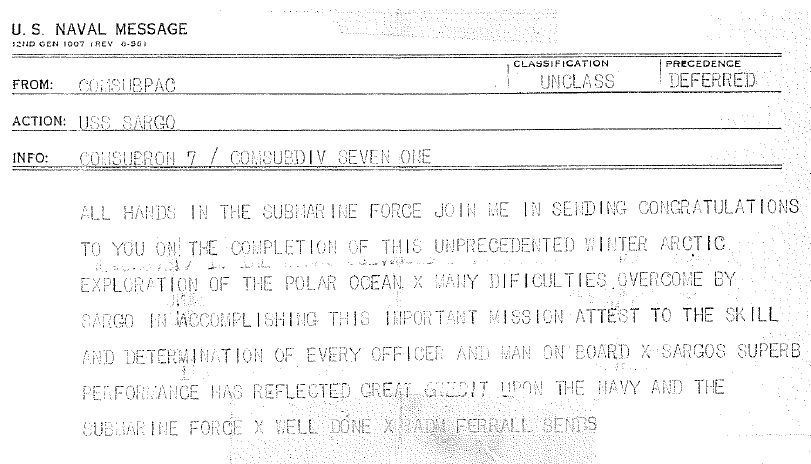
|
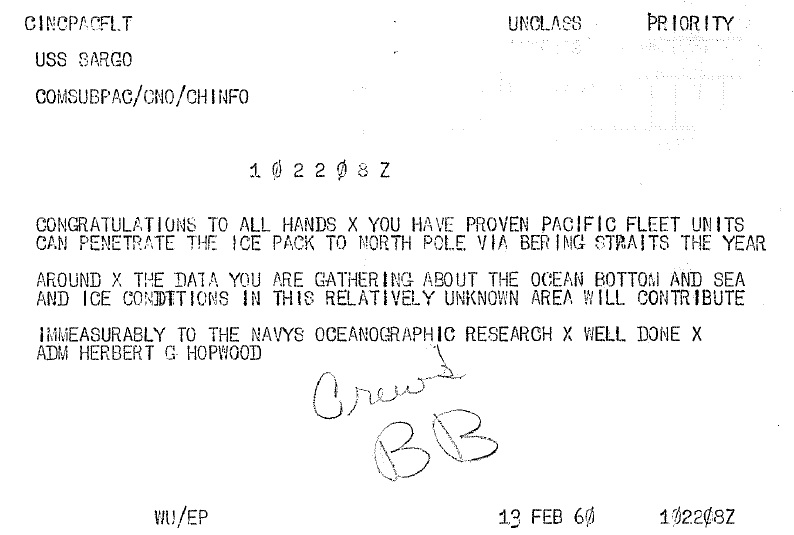
|
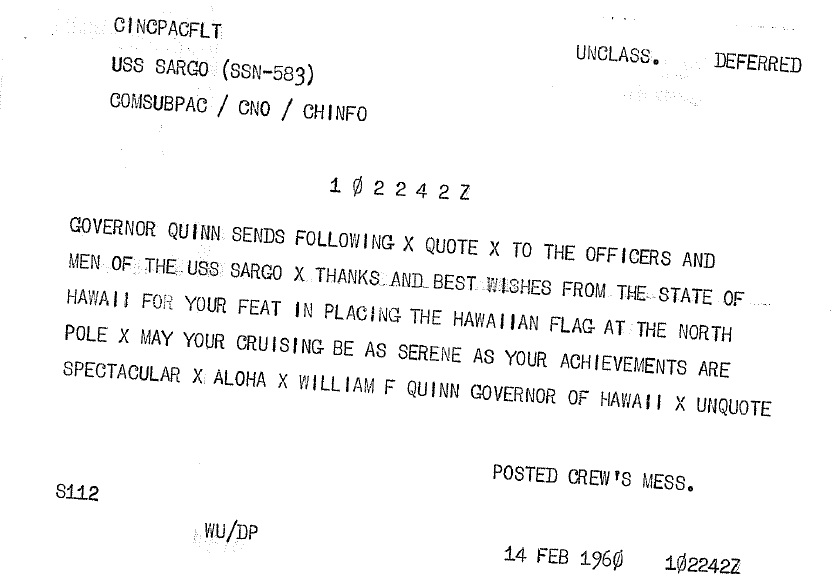
|
| On March 3, 1960 SARGO was awarded her first NAVY UNIT COMMENDATION AWARD for "successfully completing the most extensive under ice exploration of the Arctic Ocean yet attempted by a submarine including the first ... during the winter season ... despite severe weather and ice conditions." |
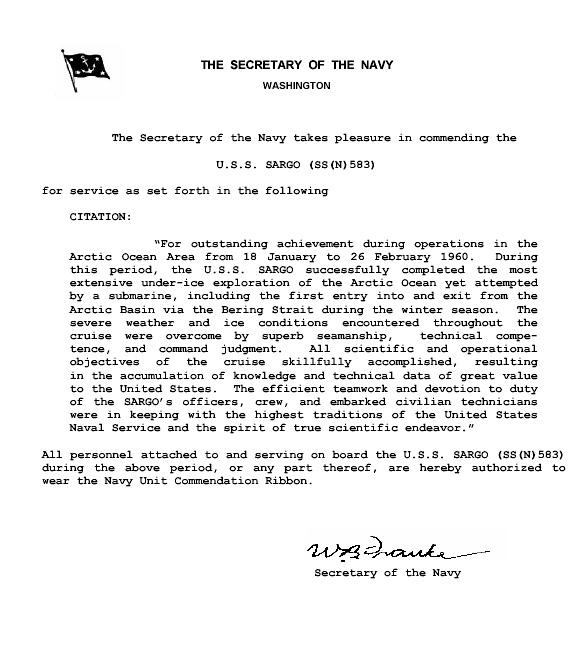
|
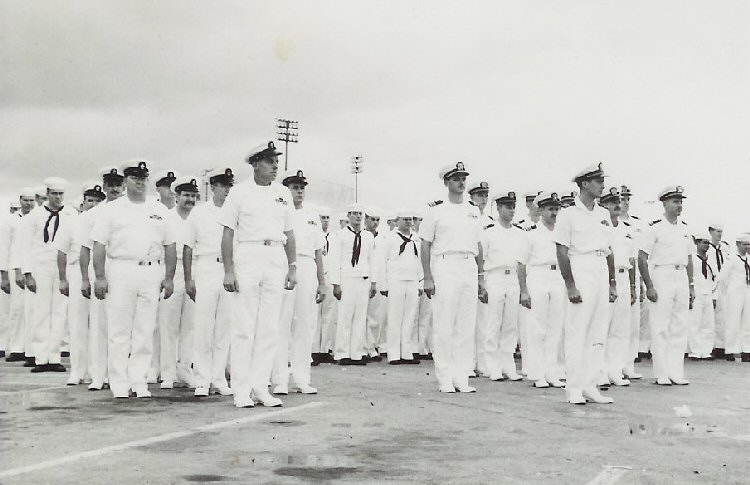 Courtesy Donald Taylor
Courtesy Donald Taylor
|
|
| Ship's Company Receiving the Navy Unit Commendation. |
| On 25 Nov 1960 the Commander, Submarine Force Pacific Fleet Public Information Office released the following: |
|
"Two Navymen on board the nuclear powered submarine USS SARGO (SSN-583) today received the Navy Commendation Medal from
the Secretary of the Navy for meritorious service during that submarines Winter Arctic Exploration Cruise earlier this year.
"Lieutenant Frederick C. Stelter, III USN, and Thomas L. Walker, Jr., chief interior communications technician, USN, received the award from Rear Admiral Roy S. Benson, USN, Commander of the Pacific Fleet Submarine Force in ceremonies on board that vessel. "Lieutenant Stelter's award was for service as diving officer. The citation accompanying the award went on to say that Lieutenant Stelter 'developed and perfected a technique for surfacing through thick ice, thereby contributing significantly to the operational capabilities of nuclear powered submarines in the Arctic. During sixteen surfacings through the ice, he personally directed the employment of his technique with faultless judgment and outstanding skill.' "The citation to Walker read: 'As leading chief petty officer of the interior communications division, Walker succeeded in devising and perfecting an ingenious variable inductance speed control which made operable a modification to a vital place of sonar equipment. Through his outstanding technical skill and ingenuity, he contributed materially to the success of the SARGO in making the difficult and hazardous transit from the Arctic Ocean through the shallow Chuckchi and Bering Seas on schedule.' "The devotion to duty of both men was in keeping with the highest traditions of the Naval service, the citations concluded. "Lieutenant Stelter is the son of Rear Admiral and Mrs. F.C. Stelter, Jr., USN, of Headquarters, U.S. Forces in Japan; and resides locally at 747 Peltier St., Radford Terrace, Honolulu. "Chief Walker is the son of Mr. and Mrs. Thomas L. Walker of 3540 Dartmouth Drive, Santa Rosa, Calif." |
| This is a link to a copy of the Navy Commendation Medal Citation |
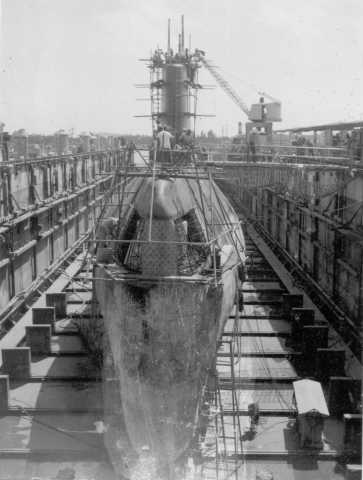 Courtesy William R. Hyde
Courtesy William R. Hyde
|
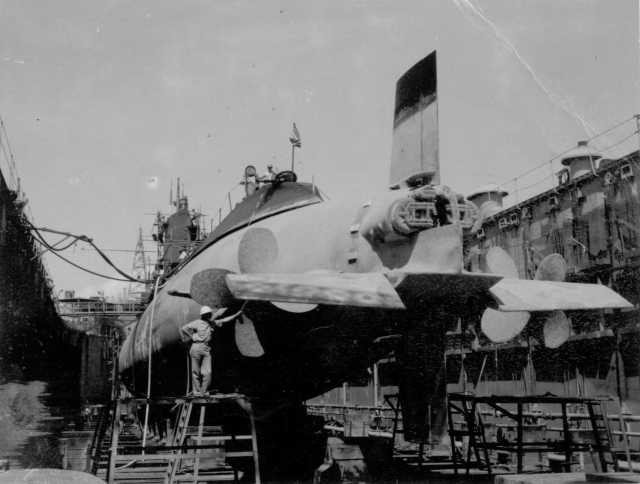 Courtesy William R. Hyde
Courtesy William R. Hyde
|
|
| USS SARGO (SSN 583) in Dry Dock for repairs. | The USS SARGO (SSN 583) in Dry Dock for repairs following the Arctic Expidetion. |
| The USS SARGO (SSN 583) was returned to service after spending some time in the Pearl Harbor Naval Shipyard to effect from the damage sustained on the arctic voyage. |

VISIT BY THE KING OF NEPAL
| On April 25, 1960 the USS SARGO was called upon to host the King of Nepal when he visited the SUBASE at Pearl Harbor, Hawaii. The SUBASE magazine PATROL reported on the tour: |
|
"A King without a Navy took his first cruise aboard a submarine on Monday, April 25th, when King Mahendra of Nepal experienced
a three-hour cruise aboard USS SARGO (SSN 583). The trip will probably be a fond memory for the Monarch who reigns over a small
Himalayan country.
"On a brief stopover in the Islands prior to his state visit to the Mainland, King Mahendra and his wife, Queen Ratna, were
entertained with tours, receptions, and the King received the submarine cruise as a guest of Admiral H. D. Felt, CINCPAC, Admiral
Hopwood, CINCPACFLT, and Rear Admiral Roy S. Benson, COMSUBPAC.
"Immediately following King Mahendra's arrival at Honolulu International Airport he was swept away by limousine in company with
Lt. Gov. James Kealola, and brought to Submarine Base for an inspection tour of USS SARGO (SSN 583) and cruise off Oahu. Prior
to the SARGO departure the King inspected the multi-service honor guard on hand for the occasion and addressed the press. Admiral
H. G. Hopwood and Rear Admiral Roy S. Benson accompanied the Monarch of Nepal on the cruise.
"After lunch the King was briefed on SARGO's recent Polar trip under the Arctic ice pack to the North Pole and back. He then toured
the submarine with Lieutenant Commander John N. Nicholson, commanding officer of USS SARGO.
"During the cruise King Mahendra was permitted to handle the controls. He took the submarine at 100 feet, put it into a 20-degree
dive and leveled off at 400 feet. Then he brought SARGO back to 100 feet and did it again.
"'It is quite a contrast to anything else I have ever done,' the King said.
"The King and Queen of Nepal and their party departed Hickam on Tuesday, April 26 aboard President Eisenhower's plane Columbine III,
and with them went fond 'Alohas' from the people of Hawaii and with the King memories of his first submarine cruise."
|

| The letter below was written by James Smallwood to his parents the morning before he took the watch for the Oxygen Load: |
 Courtesy John Smallwood
Courtesy John Smallwood
|
 Courtesy John Smallwood
Courtesy John Smallwood
|

STERN ROOM FIRE
|
On June 14, 1960 a tragedy occurred. During an oxygen-charging evolution a rupture in the charging hose caused a violent fire
in the Stern Room. A Board of Investigation published the following findings (edited for space):
14 June 1960 |
| 1330 |
USS SARGO (SSN 583), then moored to Dock S-1-B, SUBASE Pearl Harbor, started receiving oxygen, in a gaseous state, into four
banks of oxygen bottles located in the forward torpedo room. The oxygen was supplied from a mobile unit on the dock through
a hose made up of three fifty-foot sections. The mobile unit carried liquid oxygen in a 500-gallon tank and had provisions
for pumping liquid to a vaporizer on the unit, where it is converted to a gaseous state before delivery to the ship, through
the hose.
James E. Smallwood MM3(SS), attached to and serving on SARGO, was in charge of the operations on SARGO while charging oxygen banks in both the forward and after torpedo rooms. He was responsible for the proper connection of the charging hose to the manifold in the SARGO, for all that pertained to the charge from the manifold to the banks in the SARGO, and for observance of proper safety precautions in the torpedo rooms during the charge. He was not assisted or supervised by any other person during the charge. Hampton W. Boyette MMCA, while on duty and assigned to SUBASE Pearl Harbor, was in charge of the oxygen-charging mobile unit used to charge the SARGO. He was responsible for all that pertained to the charge on the mobile unit, for delivery of the oxygen through the hose up to the point of connection to the manifold in the SARGO, and for the observance of proper safety precautions on the dock and in the vicinity of the charge. During the charge he was not directly supervised by any other person. He was assisted by three other naval enlisted men. |
| 1440 |
While charging the forward torpedo room banks, the liquid oxygen pump on the mobile unit stopped and could not be restarted
again by normal means. Chief Boyette and Warren H. Spivey, ICC(SS), attached to SUBASE Pearl Harbor, examined the pump and
determined the trouble was in the pilot circuit. The pump was made operable by by-passing this circuit, eliminating three safety
features. The elimination of these safety features did not affect the proper operation of gauges, etc. and did not contributed
to the accident.
No one on the SARGO was informed as to the nature of the casualty to the pump and the fact that safety features had been eliminated. |
| 1530 | Pumping operations, to the forward torpedo room, resumed and continued without further interruption. |
| 1620 | Charging forward oxygen tanks completed. Upon securing the charge forward the mobile unit moved to a place on the dock near the stern room (after torpedo room) hatch. |
| 1645 | Charging to the three banks of oxygen bottles in the stern room was started. |
| 1700 | The section of hose, that was connected to the mobile unit, was observed to be frosting up. The pump was secured, the control valve on the manifold in the SARGO was secured, pressure was bled off the hose, the section that had frosted up was removed, the two remaining sections were used to establish the connection between the mobile unit and the SARGO. |
| 1710 | Charging to the stern room was resumed. |
| 1730 |
The following events happened almost simultaneously: the pump on the mobile unit was secured; the charging hose ruptured
about midway between the mobile unit and the SARGO with flames near the ruptured ends and along some length of the hose;
there was a loud explosive noise and a violent whipping of hose; flames and smoke came out of the stern room hatch at the
SARGO. The mobile unit was immediately disconnected and moved to safety away from the scene.
The SUBASE Fire Department was at the scene about two minutes after the accident occurred. The duty section and other personnel attached to the SARGO assisted the Fire Department personnel in fighting the fire by discharging water and foam into stern room. Because, as a safety precaution, the stern room had been isolated by dogging the watertight door to the after engine room and securing all bulkhead flappers, the smoke and flames were limited to the stern room, or to escape through the stern room hatch. The intense heat caused low order detonations of the warheads that were attached to two MK-37 torpedoes in the stern room, the only weapons in the room itself; a third warhead was attached to a torpedo in one of the after tubes and was subsequently reported to be undamaged. The intense heat in the stern room set fire to the paint on the engine room side of the bulkhead separating the engine room from the stern room and made this bulkhead "cherry red" in certain areas. SARGO personnel fought the fire and held down, as much as possible, the heat on the after engine room bulkhead until every CO2 extinguisher on board had been exhausted. Other extinguishers were obtained from nearby sources and the firefighting continued. This was done in a smoke-filled room and with the knowledge that warheads were subject to the intense heat in the adjacent compartment. Soon after the accident it was recognized that timely control of the fire in the stern room might not be possible by water and foam through hoses into the stern room hatch and a recommendation was made that the room be flooded by submerging the after section with the hatch open. |
| 1750 |
Preparations for securing the other compartments in the SARGO to permit flooding down without flooding additional spaces were
well underway when the Commanding Officer arrived on board. Upon learning of the circumstances connected with the accident,
the Commanding Officer made a prompt decision to flood the stern room by submerging it.
As a result of the accident, all hydraulic lines aft were ruptured and the vents to the after ballast tank could not be opened from the control room. |
| 1810 | The Commanding Officer and the Engineering Officer then went aft, entered the smoke-filled after engine room and succeeded in manually opening the vent to No. 3 ballast tank. The stern bottomed immediately and the after torpedo room was completely flooded through the hatch. Soon after the bottoming, an attempt to raise the stern by blowing No. 3 and No. 4 ballast tanks failed. |
| 15 June 1960 | |
| 0138 | The stern was raised using a large floating crane to take up on a cradle which had been placed under the ship. A fire hose was inserted into the after torpedo room through the hatch, a suction was taken and the water pumped down almost to deck level. |
| 0400 | An officer from the Explosive Ordnance Demolition Unit entered the compartment and found that the torpedo warheads had split open and the explosive material that had spilled into the compartment was hot and smoking. Immediately thereafter the compartment was flooded just sufficiently to cover the torpedoes, using a hose through the hatch. |
| 0900 | A five hour period was considered necessary to make certain the explosive was cooled off. At about 0900, the compartment was again pumped down and an inspection was made in which it was determined that the explosive was not dangerous. |
|
The Board of Inquiry went on to determine that:
"As a result of the explosion and fire in the after torpedo room, James Estill Smallwood MM3(SS) was killed. His death was in the line of duty and was not a result of misconduct. As a direct result of the oxygen-charging safety precaution on SARGO, which provided that only one person be in the compartment receiving the charge, and of P.O. Smallwood's conscientious insistence that this precaution be strictly observed, no other personnel casualties or injuries occurred as a result of the accident. Definite proof as to the exact cause of the explosion was not determined, although there is strong evidence to support the opinion of the Board that the explosion was a direct result of a failure in the charging hose. "The explosion on board the SARGO was not the result of any action or omission by any SUBASE or SARGO personnel, and no one of them is responsible to any extent for the accident. "The performance of duty of the following men of the USS SARGO was outstanding and in keeping with the highest traditions of the U.S. Navy:
James E. Smallwood MM3(SS); "The Commanding Officer demonstrated outstanding leadership and courage in personally directing the efforts of personnel in SARGO and in entering himself a smoke-filled compartment to effect the necessary manual operation to permit "flooding down". His maturity of judgment evidenced by his prompt decision to flood down probably prevented a major disaster." As a result of the Board of Inquiry the Navy Marine Corps Medal was presented posthumously to James E. Smallwood MM3(SS) ADM John H. Sides, Commander in Chief, Pacific Fleet presented commendations to LCDR John H. Nicholson, LT Francis L. Wadsworth, and John Kuapahi ET1(SS) RADM Roy S. Benson, Commander Submarine Force, Pacific Fleet presented commendations to LT Robert B. Connelly, Leo E. Chulos QMC(SS), Robert F. Crowley ENC(SS), Albert W. Drake EMC(SS), Linus W. Day QM1(SS), John D. Howard EM1(SS), Gary E. Tennant ET2(SS) and James L. Baugh ET3(SS) |
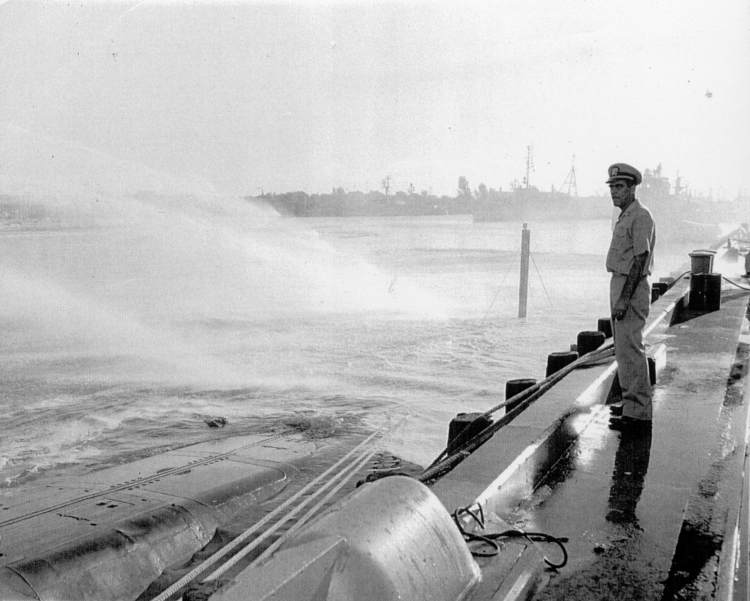 Courtesy Rufus Reaves
Courtesy Rufus Reaves
|
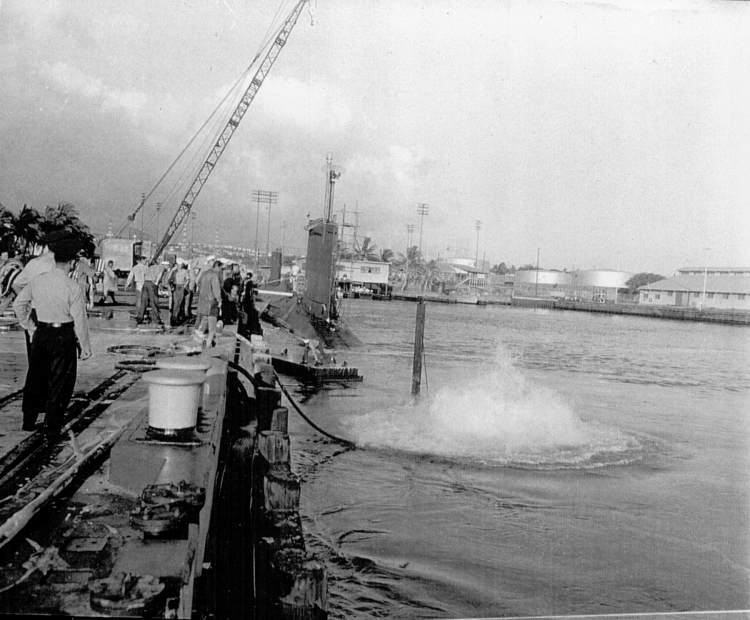 Courtesy Rufus Reaves
Courtesy Rufus Reaves
|
|
| The Stern Room Submerged. | The Stern Room Submerged. |
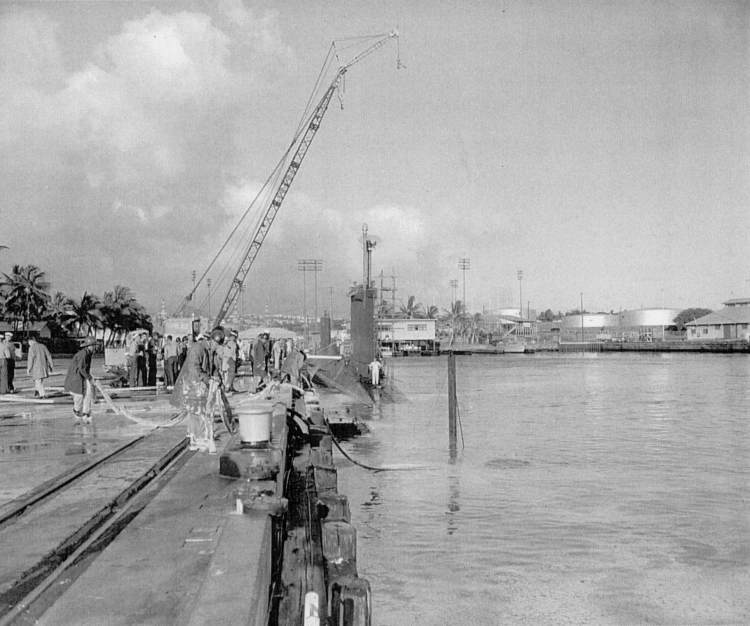 Courtesy Rufus Reaves
Courtesy Rufus Reaves
|
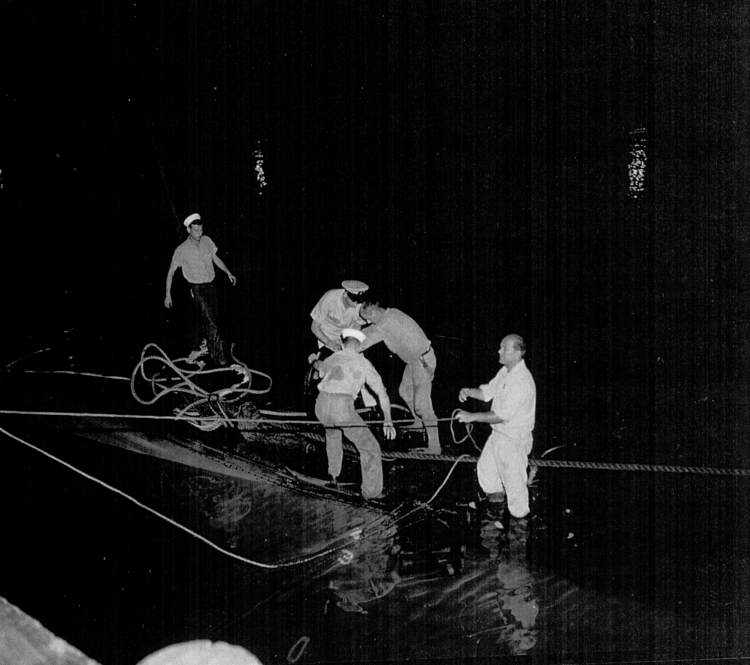 Courtesy Rufus Reaves
Courtesy Rufus Reaves
|
|
| The Stern Room Submerged. | Raising the Stern Room. |
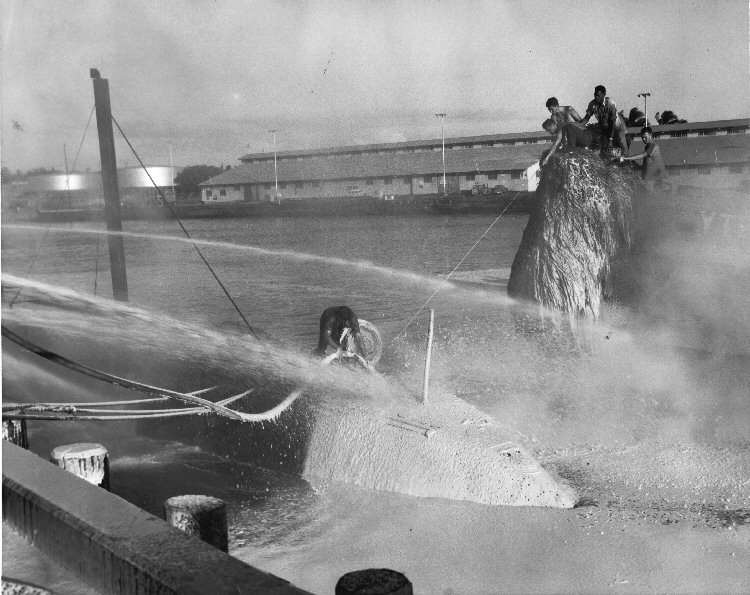 Courtesy Tom Hansen
Courtesy Tom Hansen
|
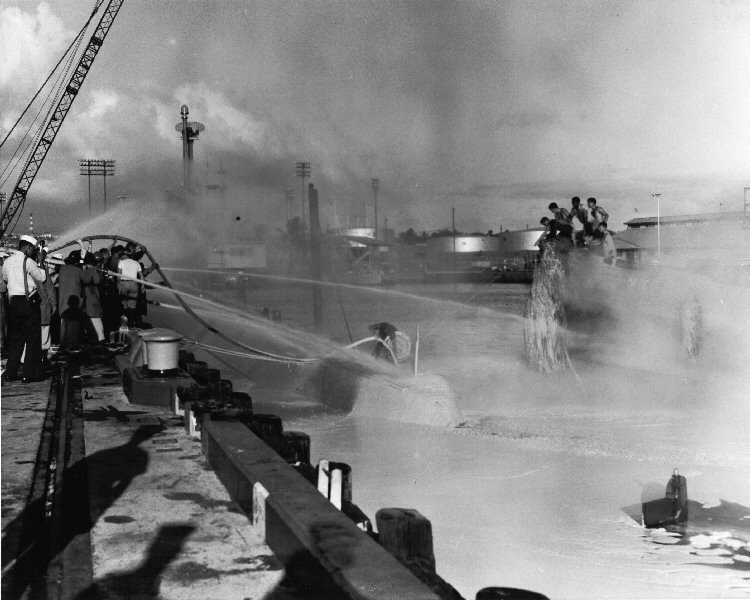 Courtesy Tom Hansen
Courtesy Tom Hansen
|
|
| Fighting the Fire. | Fighting the Fire. |
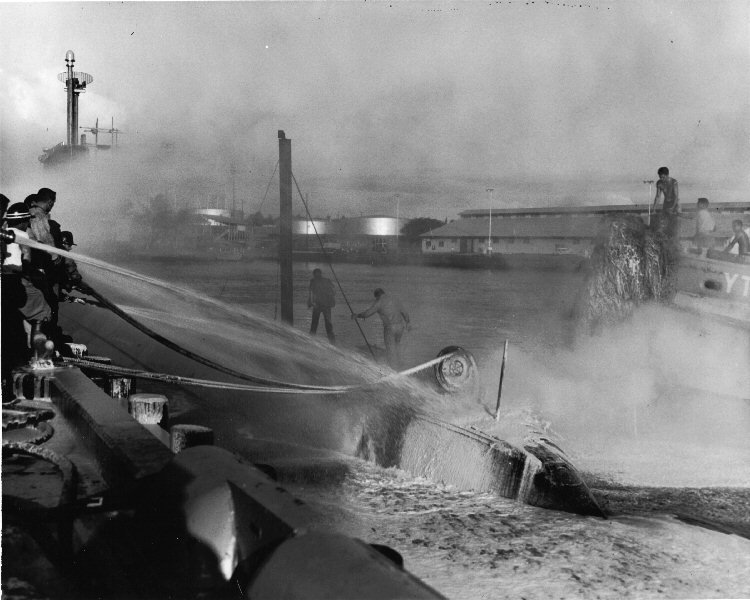 Courtesy Tom Hansen
Courtesy Tom Hansen
|
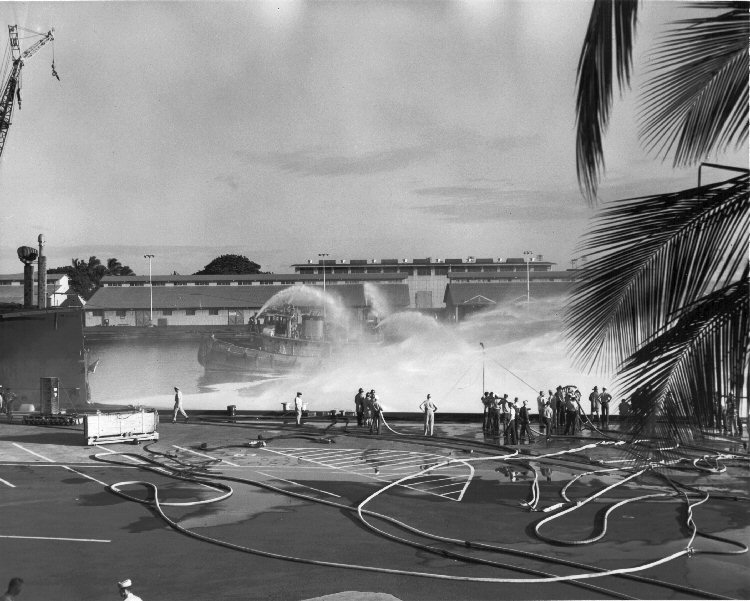 Courtesy Tom Hansen
Courtesy Tom Hansen
|
|
| Fighting the Fire. | Fighting the Fire. |

| M. Earle Palmer, RM1(SS) (1958 to 1961): |
|
"Regarding the LOX explosion on SARGO. I had the below decks watch that day, and had just turned the watch over to Smallwood,
and told him that we had finished filling the forward tanks and had commenced to fill the after tanks. I was up in the officer's
quarters storing film for an upcoming 'event', when suddenly there were two hard bumps, it felt much like the delivery boats in
the harbor when they run smack into you, hard. I ran to the control room, still trying to figure out what had happened.
"The control room was full of smoke, ash, paint bits and other debris. (Although we later learned the explosion aft had blown all of this junk up to the control room through open line and/or vents). I scooted up the conning tower hatch and, looking aft, saw red, orange and blue flames shooting high into the air. There was a deafening roar not unlike a freight train. In what seems like rapid succession, the decision was made to sink the after end, trying to contain the oxygen fire, and shortly after, we announced, 'Abandon ship.' "Two things came instinctively to mind when I first stuck my head around the conning tower: Smallwood, who had surely perished, and the two torpedoes in the after room. I was told to notify a small chapel about a block away to evacuate (there were many small children in a day-school there). On the way back to the boat, an admiral's jeep with orderly and driver stopped and chewed me out good for being uncovered, (no hat), failure to salute, and being 'filthy. I had no idea that I looked like a vaudeville 'darkie' with all the soot and junk sticking to my sweaty face. Upon learning which boat I was on, the Admiral looked down, shook his head, and then dismissed me. I borrowed a hat, fast. As to the height of the jutting flames, I'd say 100 feet to be about right, even a little conservative. "I've never forgotten Smallwood, who perished, nor will I ever forget that day. Hell of an afternoon, guys." |

| Ralph C. Bright, Jr. (son of LT Jay L. Swank): |
|
"Please have patience my hand is not steady but my heart is with all of you. Please forgive me as I am disabled so I need to get
some facts together. My Father Jay Lester Swank was an Ensign aboard the Sargo I was eleven years of age. He made the polar run
aboard her when the sail was damaged. I remember he joined Sargo at Mare Island prior to LCDR Nicholson relieving CDR Brooks, I
liked both of the skippers they were good even when things were not going good. My father made the polar run. I spent many a
weekend evening aboard with the crew watching a movie and having dinner. My father showed me that boat from the bilge to the
lookout stand atop the sail. I liked the camera system for use under the ice. He was there for the war shots sinking the LST.
Then there was the 14th June it was a normal warm day in pearl and the boat was secured to the pier hoses running to the back
hatch shore power and I remember we were bringing some things for dad because he had the duty and needed I think uniform and mom
well she would always add something for him, anyway the topside watch was close to the brow dad took the things from mom, mom
came back as I watched from the backseat of our Plymouth. I can remember asking dad what was that white smoke coming from the
area of the hoses and he replied that is not smoke son I remained silent and smiled. That was when mom put me back into the car.
Mom returned to the car as the area was secured and we could not stay or linger.
"Mom started the car and we began to move and then it happened. The boat just shook the topside watch I think ended up in the water if not him it was another. I screamed and mom stopped the car she was frozen in complete silence. Then the noise it shook the car the boat was shaking violently and then a funnel from the rear of the boat so high I couldn't see the top. First white then fire and the noise again and again every time my mother sank deeper into the seat looking at me in tears. The truck was gone so fast, hoses left then mom started the car and we left she was strong my mother. We went home and waited, waited I held my sister she was just about two or three at this time. Hours passed and then the phone rang it was the Chaplin telling us dad was OK but fighting the fire that was all he knew. I did not learn of Smallwood for some time I was told they had lost a great crew member but was not told whom it was. Dad told me about the explosion and we spoke of it numerous times especially when I joined became an engine man just like him aboard USS Menhaden SS 377 in ballast point. I understood their efforts trying to plug the holes penetrating the bulkhead of the after torpedo room as the fire tried to defeat them. Then they made the decision to dive the boat at the pier. My father said it was the cool heads of the crew doing their jobs that saved the day. The oxygen manifold began to leak Smallwood closed the hatch on himself and tried to correct the problem but he did not have the time. "I told you Smallwood was our babysitter from time to time and he was, he was quiet nice and we would watch TV until I collapsed on the couch. I was eleven so there is nothing bad just a good babysitter I have to say. Smallwood was a good sailor we played monopoly or other board games we played catch in the yard even when my sister was being a brat he was cool headed just paid her some attention and when mom and dad came home we were normally asleep. I liked him and when I learned he was lost I cried even though it was two or three years later I cried." |

| After reading Ralph Bright's reminiscences Tom Hansen, YN2(SS)(1959 to 1962) passed along the following correspondence back to Ralph [copied here with Tom's permission]: |
|
"I read the email ... with much interest and as a result of your comments I started thinking about the stern room fire
aboard Sargo. My name is Tom Hansen (stationed aboard Sargo December 1959 to May 1962) and I was the topside watch when
the explosion and fire occurred! I did not go into the water as a result of the explosion, I was however knock off my
feet, and I really don't recall that anyone one else that went into the water, contrary to your comments; but that was a
long, long time ago and I believe that I have put a great deal of the event out of my mind, as the explosion and fire was
a very traumatic event for me as an 18 year old. I do recall seeing the truck speed away, dragging the hoses behind and
I seem to remember a car leaving about the time the explosion occurred, that must have been you and your mom. I too saw
a huge plume of fire and smoke that rose from the stern room, I was awe struck by what I saw and what was happening!
"Five to ten minutes before the explosion I had been back to the stern of the boat checking the water line as that was part of the protocol for standing the topside watch in 1960 and had spoken to Jim Smallwood as he was standing in the stern room just below the hatch, as I recall we talked about one of the systems that he had responsibility for; I was working at the time on getting qualified on Sargo and getting my dolphins. Until your email I did not realize that Jim Smallwood had closed the hatch between the stern room and the engine room, that action undoubtedly saved Sargo from being damaged more than she was or worse yet being destroyed. Without doubt the closing of the Stern Room Hatch saved the guys that were on watch at the reactor station which was was just forward of the Stern Room. If I remember correctly the reactor was either being taken critical or was already on line when the Stern Room went. "Another thing just came to mind and that was the arrival of Captain Nicholson shortly after the explosion, as I recall he was out of his car and across the gang way before the car had come to a stop. If I remember correctly he was there before any emergency folks arrived. "At first I could not remember each of the officers that were on Sargo when I was there, but after thinking about the Wardroom all of Sargo Officers came back into focus, but it took a bit of time, seems as I thought of one event then that one event would move my thoughts forward and that would bring up forgotten memories and they in turn would bring up additional memories as well. I must say again that it has been a long time, close on to 50 years, a long time in the scheme of things in ones lifetime. As I recall all of the officers aboard Sargo were first rate and good guys. There was one officer, a Lt. Brown who was my qualification officer; he made me work really hard to earn my dolphins, hind sight being what it is I believe that he was correct and just, but at the time I think that I had other thoughts that were not as kind. "I have included some photos of the event that I had put away and only as a result of your email remember that I had. I hope that they are of value to you, and while they are of a sad event I hope that they will bring back good memories of your youth and your dad." |

| At the 2009 USS Sargo (SSN 583) Association Reunion in San Antonio, Texas Rolle "Ed" Stone, ETR2(SS) (1960 to 1961) saw Tom Hansen's photos and believes that he is the sailor in the two photos shown putting the hose into the Stern Room hatch as well as the photo below showing an unknown Chief who came back and told him to leave. Ed passed along what he remembered [along with comments from Mike Hacking]: |
| "I, like everyone onboard that day left the boat when the O.D. passed the word to abandon ship. We went up to the Torpedo Shops and some of us returned to begin fire fighting and damage control below decks. I know Ashwood [Kenneth R. Ashwood, IC1(SS)] and two others [probably John Y. Kuapahi, ET1(SS) and Richard L. Mooty, EM1(SS)] stayed onboard or returned to below decks and fought the fire from the Engine Room with CO2 Extinguishers and damage control plugs, to keep the fire from spreading into the Engine Room. This came out at the Board of Inquiry that I was called to testify at. I was assisting the Base Fire Department by manning a fire hose and trying to get water and foam into the stern room hatch. I then realized it was a futile effort and the only effective thing would be to get a hose through the hatch and directly on the fire. I threw a heaving line to the YTB that was fighting the fire from the other side of the boat, and tied it to a hose and we attempted to feed the hose over and into the hatch. When we realized this wouldn't work, Houston Hamilton [Houston Hamilton, IC3(SS)] tried to get to the stern room hatch, but the heat and flames were too intense. I asked the firemen on the pier and on the YTB to put the hoses on spray and I jumped down on a camel and climbed aboard and made my way to the Stern Room with the spray keeping the fire off of me and was able to force about 10 feet of hose down into the Stern Room. I do remember my eye lashes were singed and the soles of my shoes melted, however I didn't get my feet burned." |

| In a note received in July, 2010 Keith L. Bumsted, YN2(SS) (1960 to 1962) shared the following about James Smallwood: |
| "As I looked through the roster and spotted many crewmembers that I served with, there are stories about a number of them. There was a news article that ran locally last month commemorating the 50th anniversary of Jim Smallwood's death in the oxygen explosion in June, 1960. Jim was a friend of mine and it still saddens me to think of the horrible way he died. He was a great guy that everyone liked. Thankfully, it must have been quick." |

| The Honolulu Star Bulletin reported the fire on 15 June 1960: |
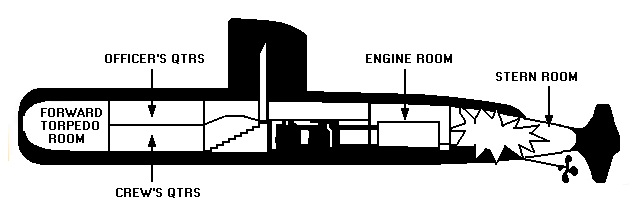 ATOMIC SUB EXPLOSION HERE; FIRE SWEEPS TORPEDO ROOM
"Sargo Sunk After Blast - An explosion and fire, fed by highly flammable oxygen, rocked the $50 million nuclear
submarine Sargo at its berth in Pearl Harbor yesterday evening. The torpedo room hatch was left open deliberately in order
to put out the blaze. The giant sub was deliberately submerged with its stern room hatch open to put out the fire.
"THE NAVY Department said at least one man, and possibly two crewmen, aboard the submarine at the time of the blast was
missing. A Navy spokesman said the sub's atomic reactors had been sealed off prior to the explosion and there was no threat
of radiation. The spokesman said the 5:30 p.m. explosion was caused by leakage in the connection of a rubber hose which was
pumping high pressure oxygen into the sub. The oxygen is used by the crew when the sub is submerged.
"GUARDS AT the Pearl Harbor main gate said they heard five sharp explosions, at 5:43 p.m. Earlier, smoke could be seen coming
from the Sargo's berth at the submarine base. The Sargo had just been released from drydock yesterday. The fire was fought by
two Pearl Harbor fire-boats, naval base fire trucks, and equipment from nearby Hickam Air Force Base.
"THE SUB was partially submerged shortly before 6 p.m. to put out the flames in the affected comparments. Later, the Navy
began blowing air into the Sargo to clear the water and refloat her. Pumps were being used to drain the sub and allow
firefighters to go below decks to see if anyone had been trapped in the blast. The sub's skipper, Lt Cmdr. John H. Nicholson,
35, was not aboard at the time. He hurried from home, however, and was on the scene directing operations last night.
"ALSO RECALLED from their homes were many Sargo crewmen. The salvage scene at the berth of the stricken Sargo was one of great
activity and concentrated effort. Generators hummed to supply a battery of flood lights which lit the scene. Underwater lights
threw up an eerie green glow from the bottom, where the Sargo's stern rested.
"THE SURFACE of the water roiled with the bubbles of divers who worked in two-man shifts of half an hour. Shepherding the whole
operation was Roy S. Benson, commander of the Pacific Submarine Force. The admiral strode up and down the pier watching a team
of about 100 men trying to surface the damaged submarine. 'This shoud prove how safe the effects of an explosion a nuclear
submarine really is.' he said."
|

ADDITIONAL NEWSPAPER ARTICLES FOR THE
STERN ROOM FIRE

|
The USS SARGO spent June through September in the shipyard effecting repairs to the stern room, before being returned to service.
During the remainder of the year USS SARGO conducted type training exercises in the Pearl Harbor area, including the first SSN vs. SSN exercises held in the Pacific. |
| Keith L. Bumsted, YN2(SS) (1960 to 1962) forwarded the following pictures taken of the USS SARGO off of the coast of Hawaii on 03 Dec 1960. These are official U.S. Navy photographs taken by the Fleet Air Photographic Laboratory VU-1 N.A.S. Barbers Point as the ship returned to port: |
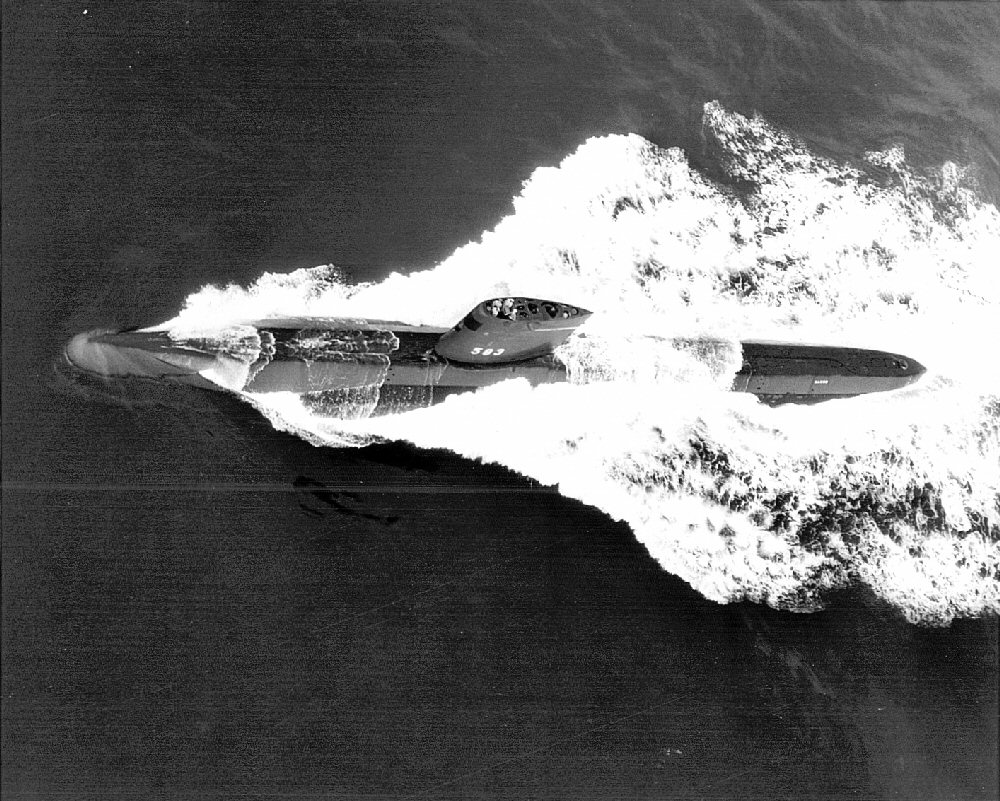 Courtesy Keith Bumsted
Courtesy Keith Bumsted
|
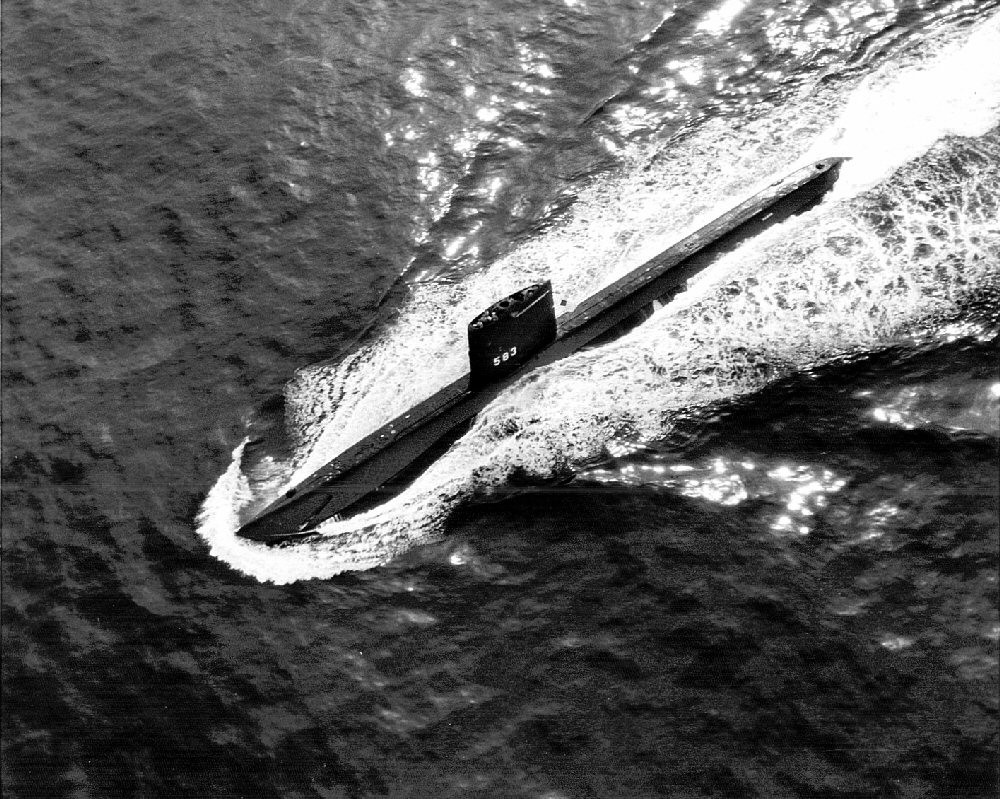 Courtesy Keith Bumsted
Courtesy Keith Bumsted
|
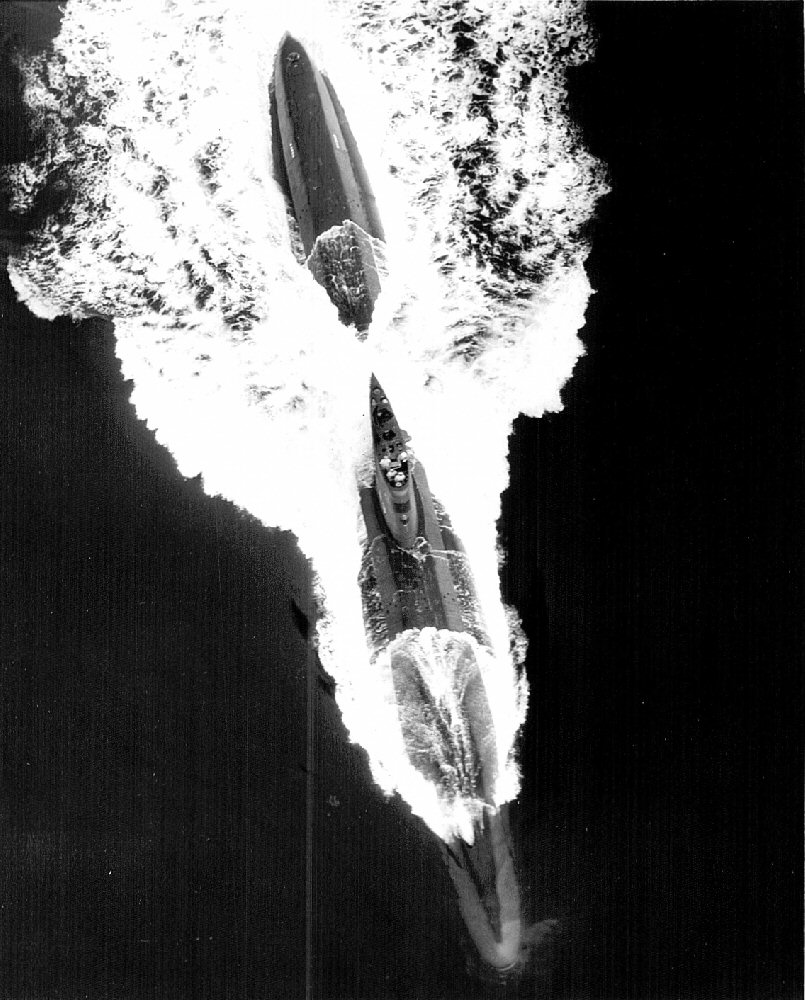 Courtesy Keith Bumsted
Courtesy Keith Bumsted
|
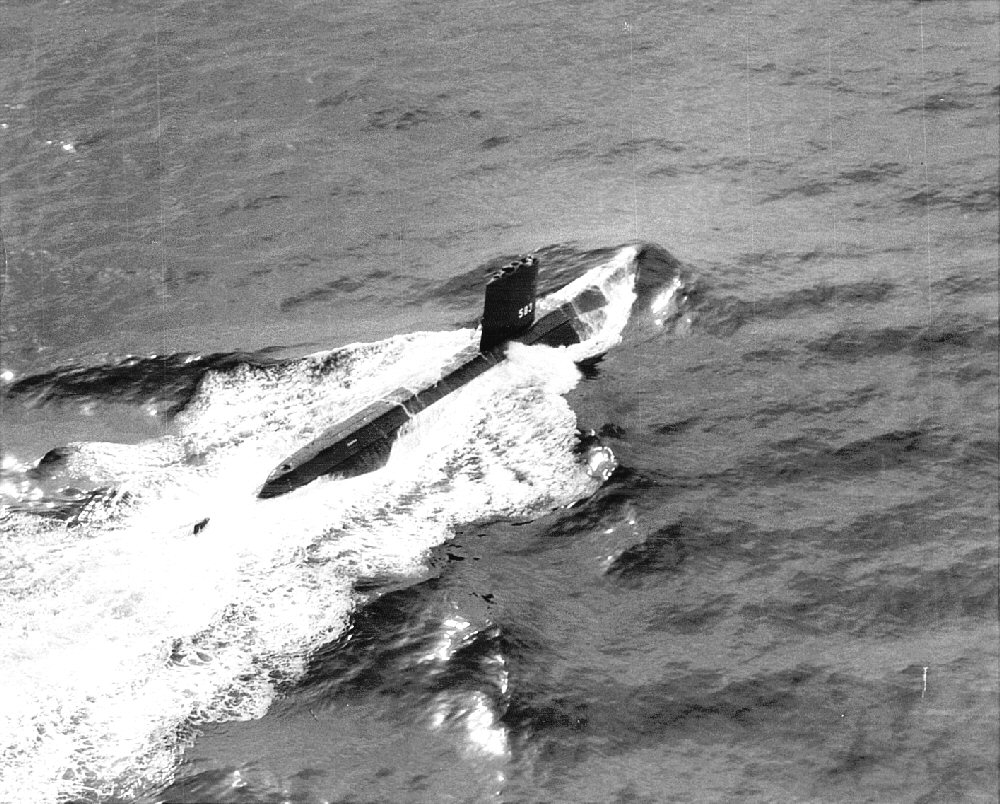 Courtesy Keith Bumsted
Courtesy Keith Bumsted
|
| The following picture was taken of the three SKATE Class submarines stationed in Pearl Harbor on 03 Dec 1960. The ships (Top to Bottom) are USS SEADRAGON (SSN 584), USS SARGO (SSN 583), and USS SWORDFISH (SSN 579): |
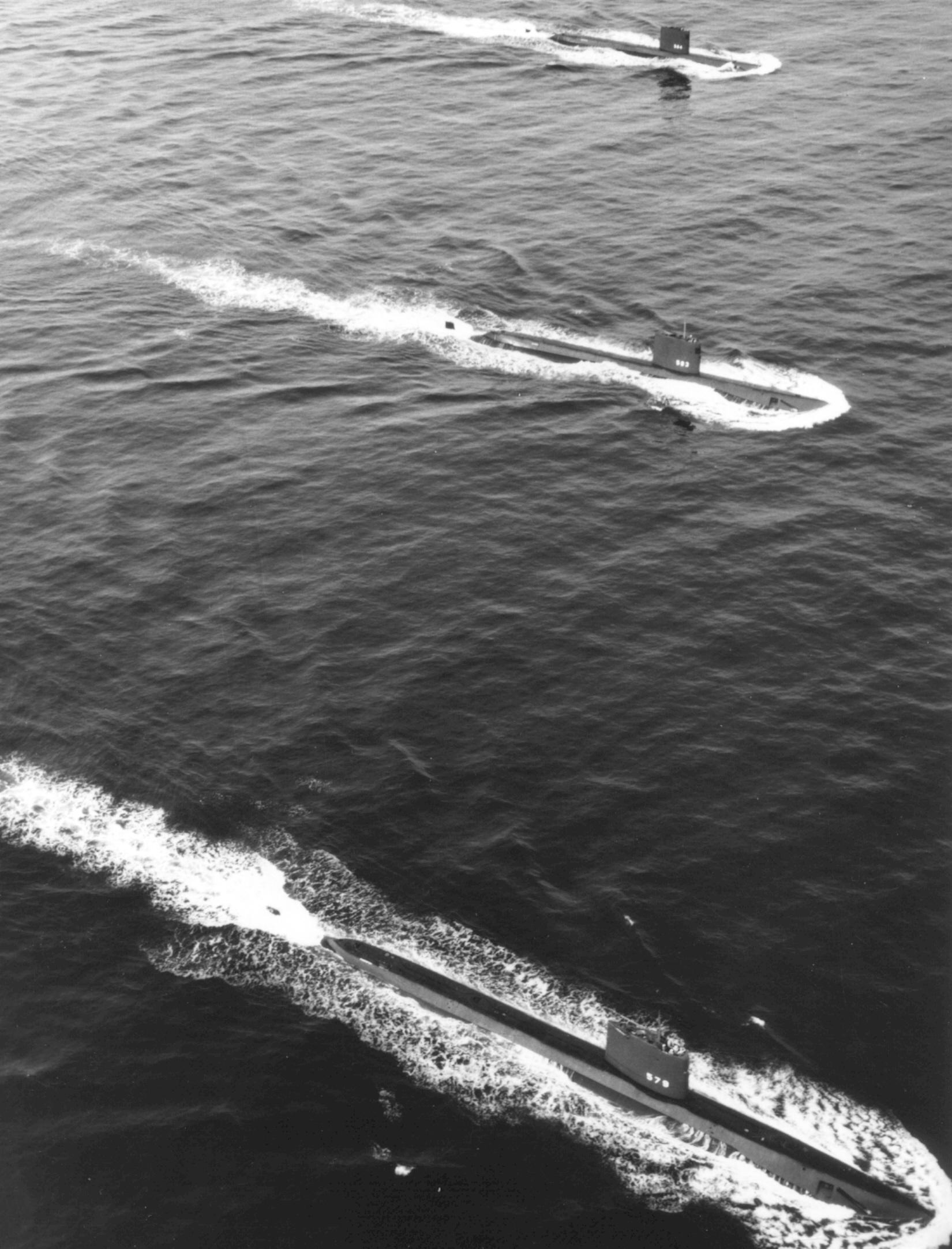 Courtesy Don Scott
Courtesy Don Scott
|
